Ushuaia, the southernmost city in the world, is a breathtaking location situated in Tierra del Fuego, Argentina. This city is renowned for its natural beauty, featuring stunning mountain ranges, pristine lakes, and diverse fauna.
One of the most fascinating aspects of wildlife in Ushuaia is its bird species. The city and its surrounding areas offer a unique habitat for several remarkable bird species that are not found in many other locations in the world.
From majestic eagles to tiny hummingbirds, the birdlife in Ushuaia is diverse, impressive, and a sight to behold.
This article explores the different types of birds that can be found in Ushuaia, their unique characteristics, and the significance of their role in the ecosystem of this remote and stunning region.
1. Brown-Hooded Gull
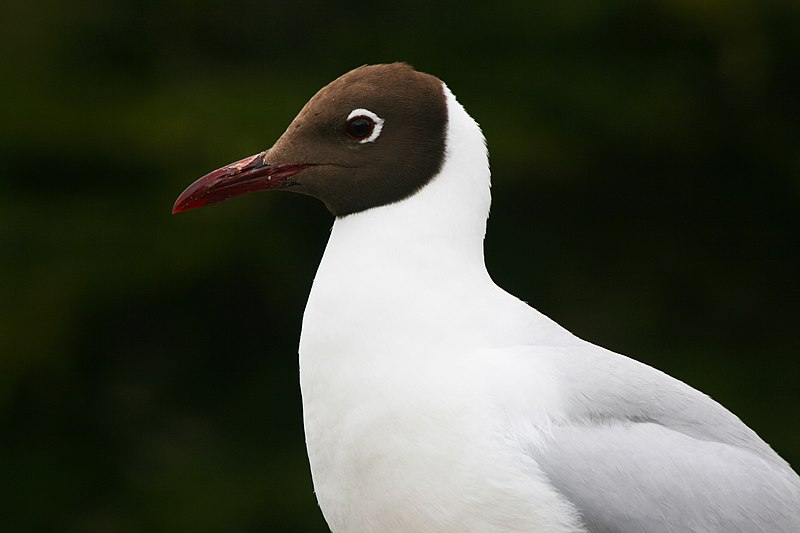
The brown-hooded gull is a species of white seabird found in South America. It has red beak and feet, and its most distinctive feature is the dark brown head with a white semicircle around the back part of each eye.
The bird’s scientific name, Chroicocephalus maculipennis translates to ‘spotted wings’ which refers to its spotted wing feathers.
This gull can typically be seen along coasts or near bodies of water where it feeds on fish, insects, crustaceans and mollusks.
They are also known for their long distance migrations from Argentina all the way up to Uruguay during winter months when food becomes harder to find closer by shorelines.
To protect themselves they build nests high above ground usually made out of twigs lined with grass and other materials nearby them like seaweed or shells that they scavenge while searching for prey underwater throughout day light hoursScientific classification:
| Kingdom | Animalia |
| Phylum | Chordata |
| Class | Aves |
| Order | Charadriiformes |
| Family | Laridae |
| Genus | Chroicocephalus |
| Species | C. maculipennis |
Also Featured In: Birds of Argentina,
2. Magellanic Penguin
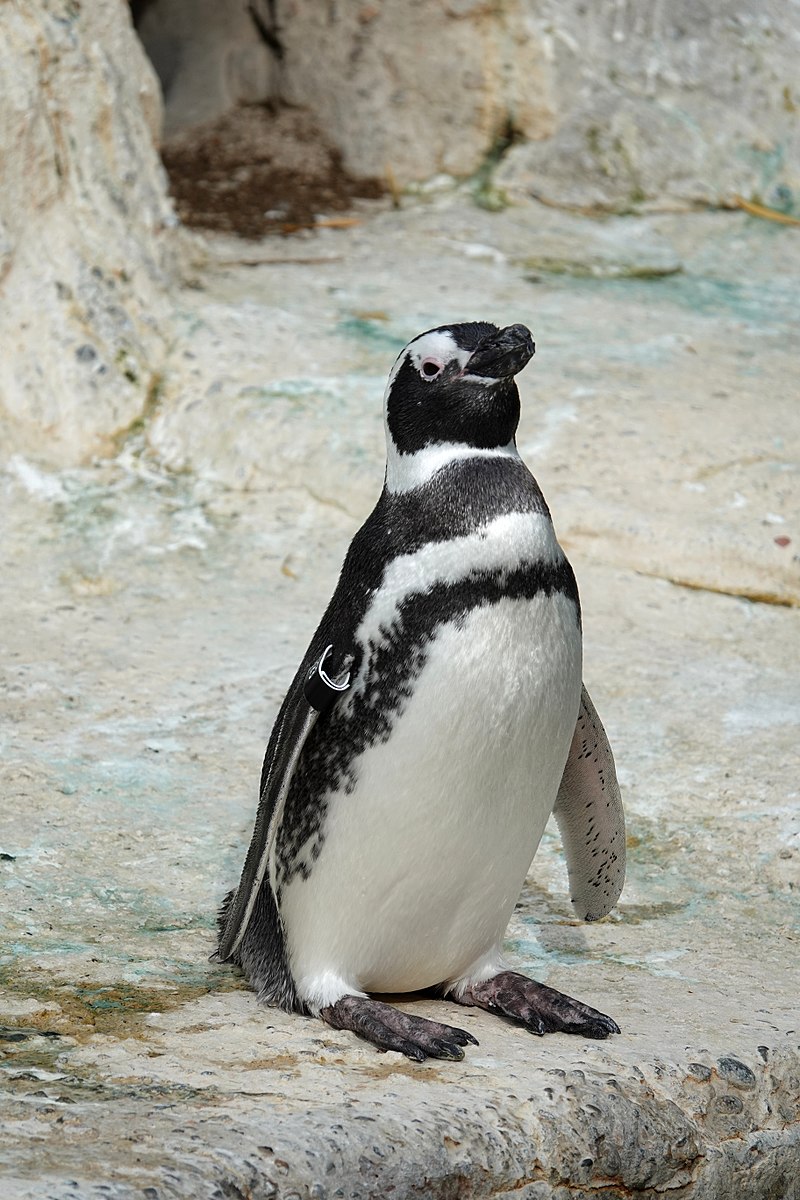
The Magellanic penguin is a beloved South American bird that breeds in coastal Patagonia, including Argentina, Chile and the Falkland Islands. It migrates to Brazil and Uruguay occasionally as far north as Espirito Santo.
Vagrants have even been spotted in El Salvador, Antarctica’s Avian Island and Australia/New Zealand.
This species of penguin is perhaps most recognizable for its striking black-and-white plumage – it has an entirely white underbelly with two distinctive stripes across its back which are black above and white below.
Additionally, they possess large pinkish feet which act like paddles when swimming underwater; these birds can swim up to 20 mph.
The Magellanic Penguin typically lives around 15 years but some may live longer due to their strong social bonds within colonies.
All in all this majestic creature makes quite the statement both on land or sea – making them a unique addition our planet’s wildlife population.Scientific classification:
| Kingdom | Animalia |
| Phylum | Chordata |
| Class | Aves |
| Order | Sphenisciformes |
| Family | Spheniscidae |
| Genus | Spheniscus |
| Species | S. magellanicus |
Also Featured In: Most Common Birds in South America Birds, Birds That Live around Saunders Island
3. Chilean Skua
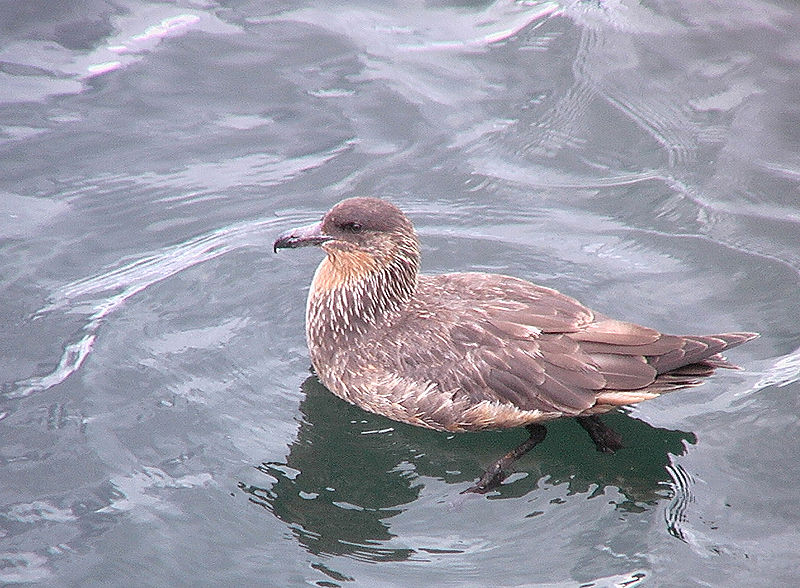
The Chilean skua is a large predatory seabird found in South America. It can be recognized by its dark cap that contrasts with the cinnamon colored throat and lower face.
These birds often wander as far north as Brazil and Peru when not breeding, but are primarily concentrated around Argentina and Chile.
Hybridization between this species of skua and brown skuas has been observed in southern Argentina.
The Chilean Skua measures approximately 55 cm long making it smaller than some other varieties of sea bird, however they make up for their size with aggression towards competitors or intruders near nesting areas.Scientific classification:
| Kingdom | Animalia |
| Phylum | Chordata |
| Class | Aves |
| Order | Charadriiformes |
| Family | Stercorariidae |
| Genus | Stercorarius |
| Species | S. chilensis |
Also Featured In: Most Unique Birds in Peru,
4. Austral Pygmy Owl
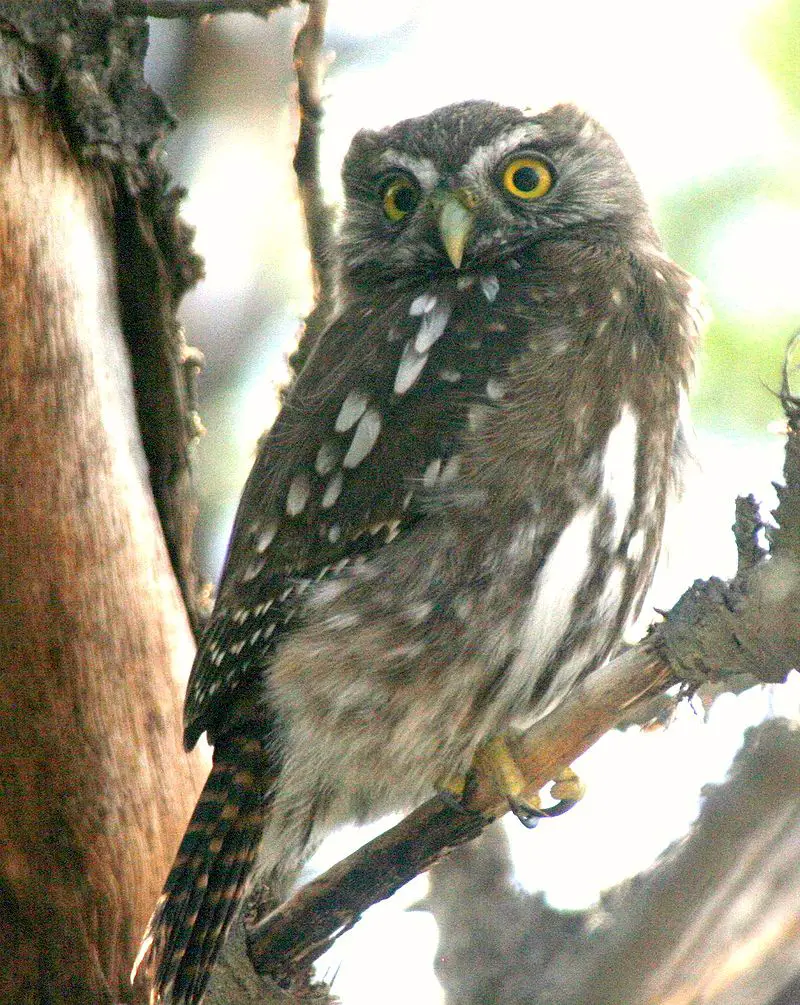
The Austral Pygmy Owl is a species of owl that resides in Argentina and Chile. It has sometimes been mistaken as a subspecies of Ferruginous Pygmy Owl, but DNA studies have proven it to be its own unique species.
Measuring up to 21 cm in length, the Austral Pygmy Owl has distinctive reddish-brown feathers with white spotting on its wings and tail.
Its eyes are bright yellow while its facial disc is striped brown or grey depending on the individual bird’s colouration patterning.
This small nocturnal hunter preys mostly on insects such as grasshoppers, crickets, moths and beetles which can often be found in open habitats like grasslands fields near water sources such as lakes or rivers where they also nest among trees for protection from predators during daylight hours.
The Austral Pygmy Owls are an important part of their local ecosystems providing insect control without harming other wildlife populations which makes them vital members of their environment.Scientific classification:
| Kingdom | Animalia |
| Phylum | Chordata |
| Class | Aves |
| Order | Strigiformes |
| Family | Strigidae |
| Genus | Glaucidium |
| Species | G. nana |
Also Featured In: Most Common Birds Found in Chile,
5. Upland Goose
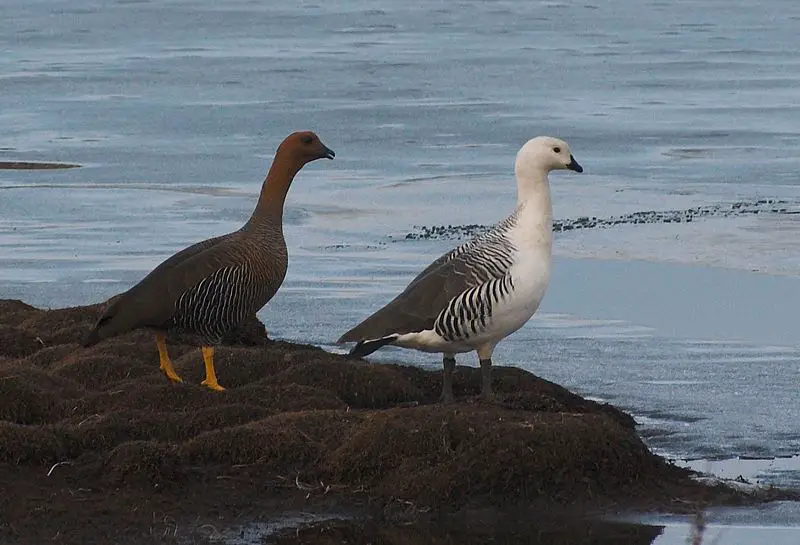
The Upland Goose, also known as the Magellan Goose, is a species of sheldgoose belonging to the Anatidae family.
With its similar habits and appearance to true geese, this bird has two recognized subspecies – Chloephaga picta leucoptera and C. p. picta which inhabit regions in South America such as Patagonia and Tierra del Fuego respectively.
They are highly sociable birds that live in small flocks or pairs on open grassland with access to water sources for bathing and twilight feedings when they hunt for food items like insects, worms or molluscs.
Their feathers range from brownish grey colours along their wings while white underparts give them an overall spotted effect making these birds very attractive creatures.Scientific classification:
| Kingdom | Animalia |
| Phylum | Chordata |
| Class | Aves |
| Order | Anseriformes |
| Family | Anatidae |
| Genus | Chloephaga |
| Species | C. picta |
6. Great Grebe
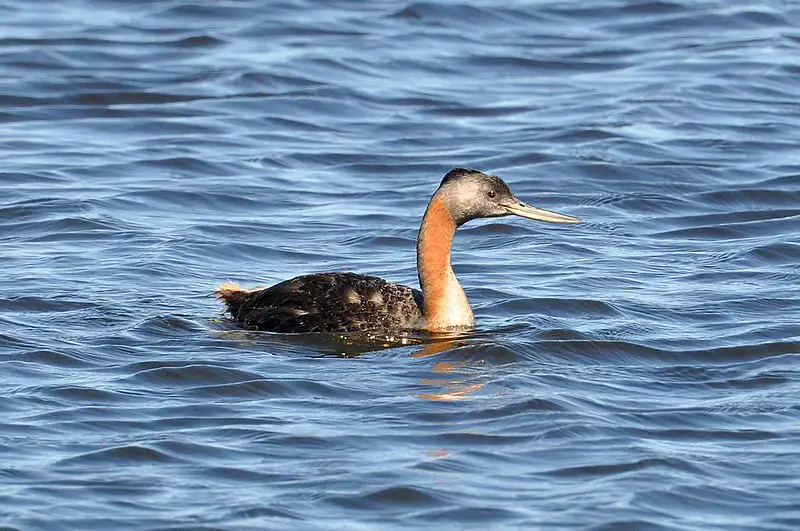
The Great Grebe is a majestic bird that stands out from other species of grebes thanks to its size. It has an extensive range, stretching across extreme southeastern Brazil all the way down to central Chile and Patagonia.
A distinct subspecies of this species can be found in southern Chile, known as P. m. navasi.
This remarkable creature was first described by French polymath Georges-Louis Leclerc, Comte de Buffon in 1781 who marvelled at it’s unique features such as its long slender neck and heavy bill which make it stand out among waterfowls around the world today.Scientific classification:
| Kingdom | Animalia |
| Phylum | Chordata |
| Class | Aves |
| Order | Podicipediformes |
| Family | Podicipedidae |
| Genus | Podiceps |
| Species | P. major |
7. Fire-Eyed Diucon
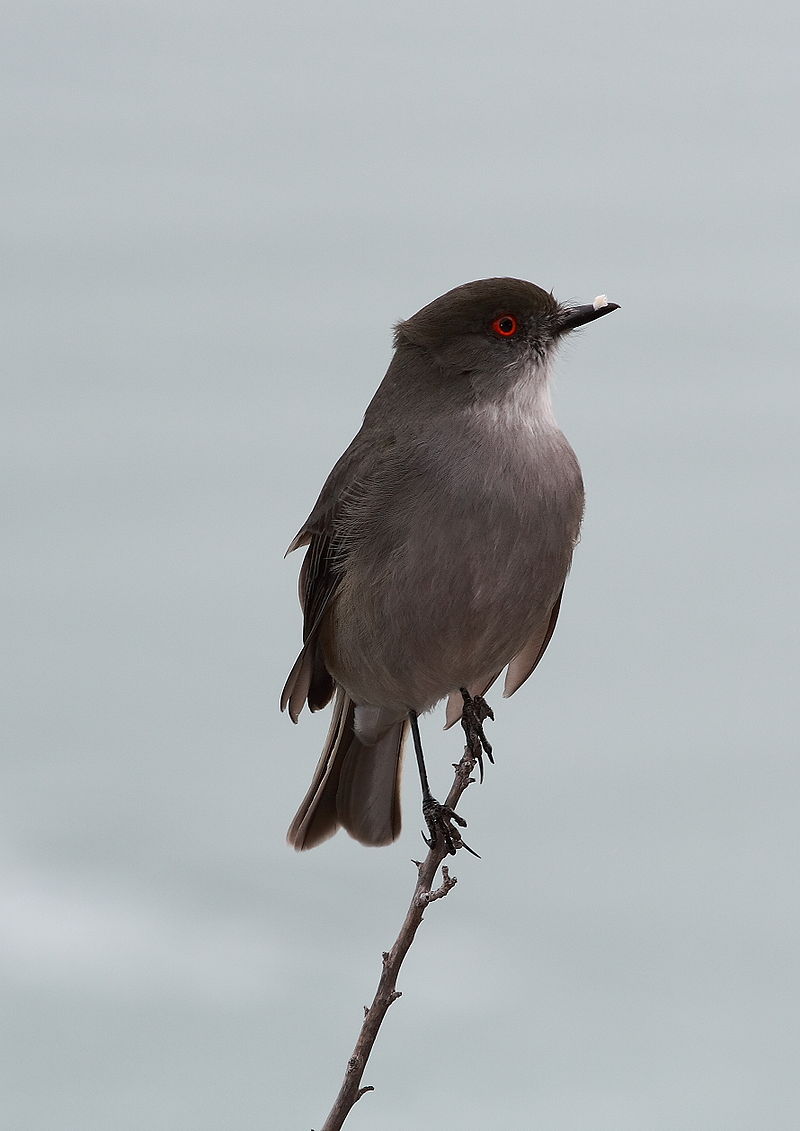
The Fire-eyed Diucon is a unique species of passerine bird belonging to the Tyrannidae family, found in Central and South America.
It has an impressive 19–21 cm length with grey upperparts and pale grey underparts with white throat and undertail coverts.
Its most distinct feature is its bright coral-red eyes, for which it was named after. The diucon also makes distinctive call sounds like ‘tche’ or ‘dzee’ that can be heard during all times of day as well as night, often repeated several times over in succession.
This beautiful creature lives mainly on insects but will sometimes make use of fruits when other food sources are scarce.
They prefer open areas such as shrubby hillsides and woodlands where they find plenty of their favourite snacks.Scientific classification:
| Kingdom | Animalia |
| Phylum | Chordata |
| Class | Aves |
| Order | Passeriformes |
| Family | Tyrannidae |
| Genus | Pyrope Cabanis & Heine, 1860 |
| Species | P. pyrope |
8. Grey-Flanked Cinclodes
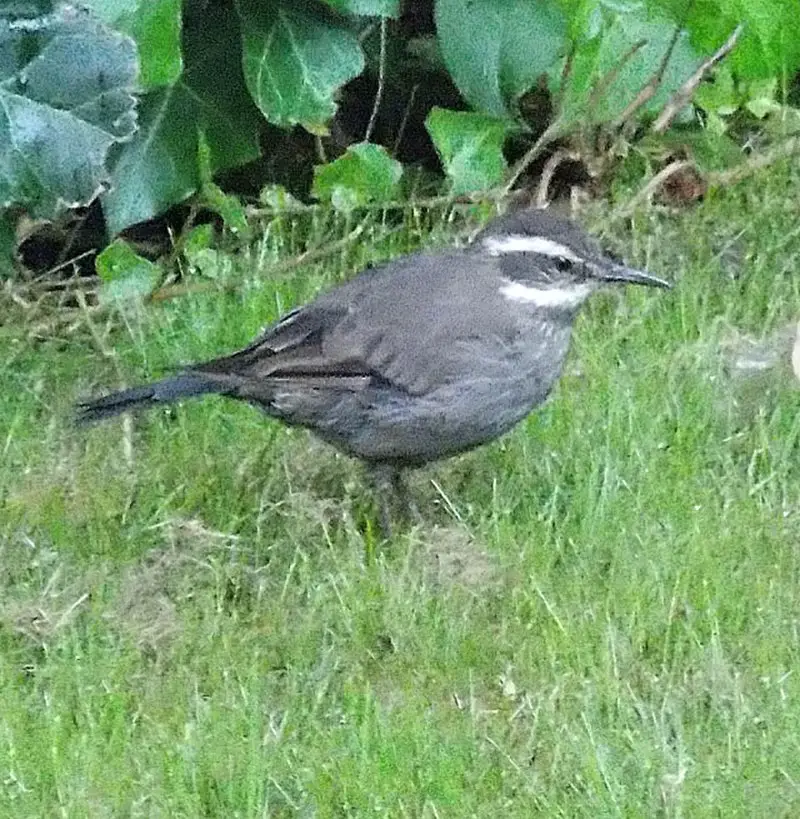
The Grey-flanked Cinclodes is a species of bird found in Chile, Argentina and Tierra del Fuego. It inhabits subtropical or tropical dry shrubland and high altitude shrubland.
Its plumage is greyish brown with rufous crown and wings, white supercilium and cinnamon streaked underparts.
This small passerine feeds on insects that it finds amongst the ground vegetation as well as seeds from plants like grasses, sedges and herbs.
Breeding season occurs between October to December during which they build nests made up of sticks lined inside with soft material such mosses or feathers near streams among rocks.
Sadly this species has been classified vulnerable due to destruction of its natural habitats by humans for agriculture purposesScientific classification:
| Kingdom | Animalia |
| Phylum | Chordata |
| Class | Aves |
| Order | Passeriformes |
| Family | Furnariidae |
| Genus | Cinclodes |
| Species | C. oustaleti |
9. South American Tern
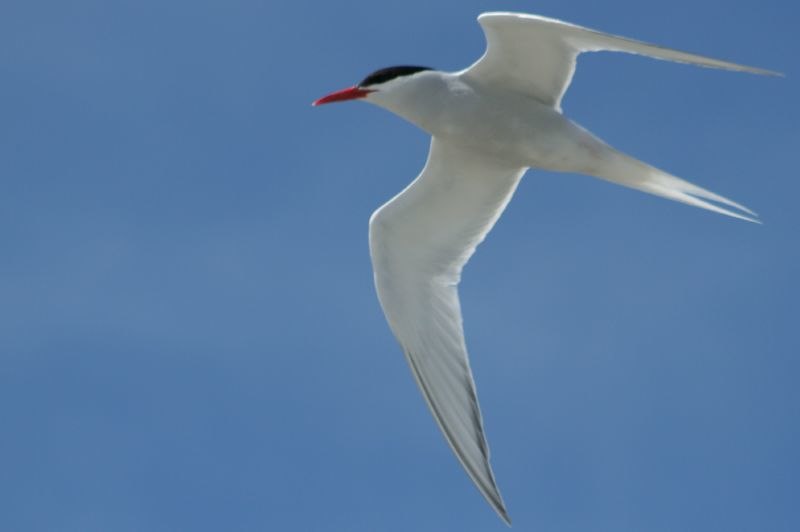
The South American tern is a species of seabird found in coastal regions stretching from the Falklands to Peru and Brazil.
True to its name, this bird has a swallow-like forked tail that helps it soar through the sky with ease.
It also has an impressive wingspan, making it quite easy to spot when flying overhead.
The most distinguishing characteristic of these birds is their bright yellow beak and feet which contrast against their white head and grey body plumage.
They are considered one of the most common terns in their range due to their adaptability across different habitats such as mudflats and beaches or even grassy areas near riversides or lakeshores.
While they usually reside close enough inland so as not to come into contact with humans directly, they can often be seen soaring high above our heads on sunny days.Scientific classification:
| Kingdom | Animalia |
| Phylum | Chordata |
| Class | Aves |
| Order | Charadriiformes |
| Family | Laridae |
| Genus | Sterna |
| Species | S. hirundinacea |
Also Featured In: Uruguay birds,
10. Southern Fulmar
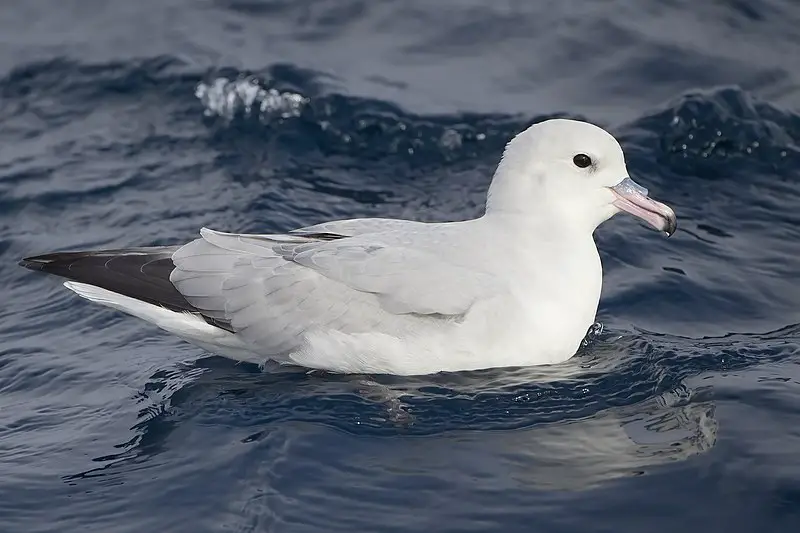
The Southern fulmar is a species of seabird found in the southern hemisphere. It has an overall pale grey body and white underparts, with a unique white patch on the wings.
Its breeding season takes place mainly along coastlines, where it builds its nest to lay eggs.
These birds are often seen soaring through the skies or bobbing atop waves near coasts during their migration periods as they search for food which includes fish, squid, crustaceans and other marine creatures.
Their diet also consists of carrion such as dead seals or whales floating at sea that are scavenged upon by these opportunistic omnivores.
With increasing concern over environmental protection and conservation efforts for oceanic wildlife habitats worldwide, this remarkable species will no doubt continue to play an important role in maintaining balance within our fragile ecosystems across the globe.Scientific classification:
| Kingdom | Animalia |
| Phylum | Chordata |
| Class | Aves |
| Order | Procellariiformes |
| Family | Procellariidae |
| Genus | Fulmarus |
| Species | F. glacialoides |
Also Featured In: Antarctica Birds, Most Common Birds in Stewart Island
11. King Penguin
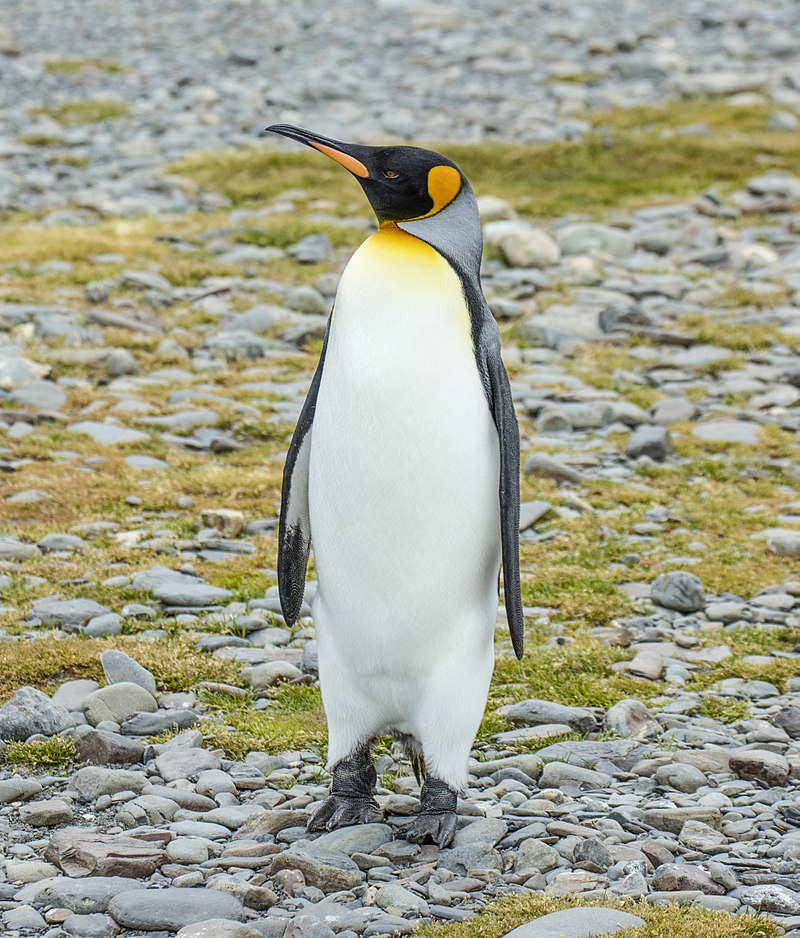
King penguins are majestic birds that live in the temperate and sub-Antarctic regions of the South Atlantic and Indian Oceans.
They stand up to 3 feet tall, making them smaller than their relative, the Emperor Penguin.
King Penguins have a distinctive two toned orange and black plumage with white markings on its face around its eyes which gives it an elegant look.
Unlike other species of penguin, they don’t migrate as much but stay close to breeding grounds year round living off from fish and squid found near shorelines or ice floes.
Their diet also consists of krill shrimp, small crustaceans such as copepods or amphipods eaten whole along with some occasional planktonic organisms like jellyfish for variety.
King Penguins form large colonies where males take part in incubation duties while females feed at sea for weeks at a time during mating season.Scientific classification:
| Kingdom | Animalia |
| Phylum | Chordata |
| Class | Aves |
| Order | Sphenisciformes |
| Family | Spheniscidae |
| Genus | Aptenodytes |
| Species | A. patagonicus |
12. Brown Skua
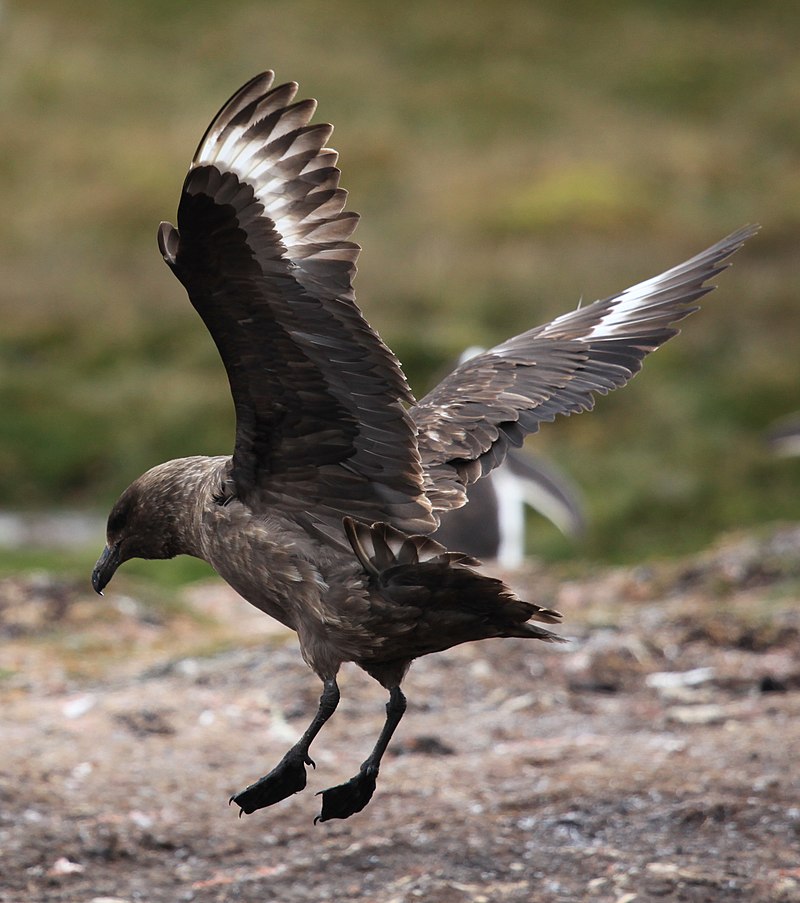
The brown skua is a large seabird found in subantarctic and Antarctic regions, often moving further north to find food when not breeding.
It goes by many names including the Antarctic Skua, Southern Great Skua or Hākoakoa (Māori).
Its taxonomy has been disputed with some believing it should be split into two or three species like Falkland Skuas.
The Brown Skuas are mostly dark grey-brown on top with white bellies and have long wings that enable them to fly great distances over vast oceans searching for food.
They feed mainly on fish but also scavenge from other animals’ kills such as penguins and petrels.
In their natural environment they form strong social bonds which help protect their young ones against predators while nesting near colonies of birds in the grasslands surrounding Antarctica’s coasts.Scientific classification:
| Kingdom | Animalia |
| Phylum | Chordata |
| Class | Aves |
| Order | Charadriiformes |
| Family | Stercorariidae |
| Genus | Stercorarius |
| Species | S. antarcticus |
Also Featured In: Common Birds Found near Saint Helena,
13. Gentoo Penguin
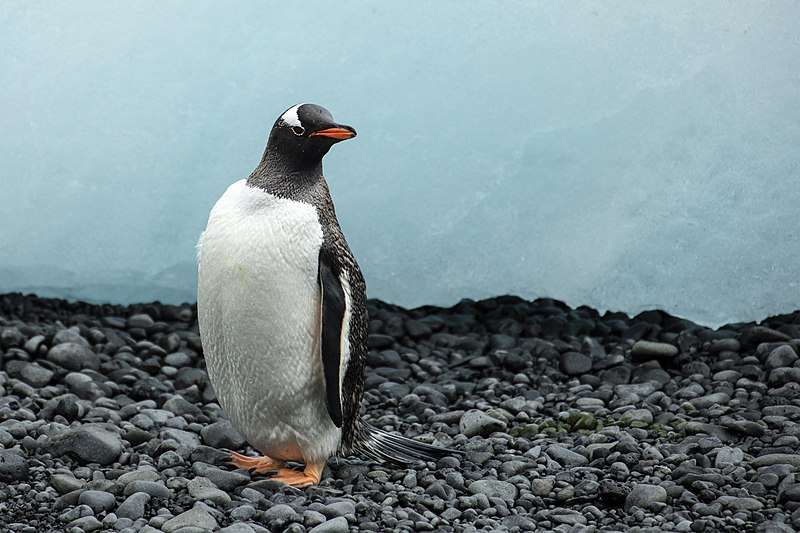
Gentoo penguins are an iconic species of birds found in the Falkland Islands. They have a distinctive black and white plumage, with a bright orange beak and feet.
The gentoo is one of three closely related species—the Adélie Penguin (P. adeliae) and chinstrap penguin (P. antarcticus)—and they can all be seen co-existing in their natural habitat near open water or on ice shelves around Antarctica, including the South Shetlands, Orkneys, South Georgia islands, Kerguelen Islands and Macquarie Island to name just a few places.
This sociable bird is known for its loud call which sounds like “gentooooo”; it also makes other vocalizations such as honks during courtship displays.
Gentoos prefer to live in large colonies but will often nest alone or form small groups when needed.
With climate change having an increasingly negative effect on Antarctic habitats these days it’s more important than ever that we protect this fascinating animal so future generations may enjoy them too.Scientific classification:
| Kingdom | Animalia |
| Phylum | Chordata |
| Class | Aves |
| Order | Sphenisciformes |
| Family | Spheniscidae |
| Genus | Pygoscelis |
| Species | P. papua |
Also Featured In: Birds That Live In Heard Island and McDonald Islands,
14. White-Chinned Petrel
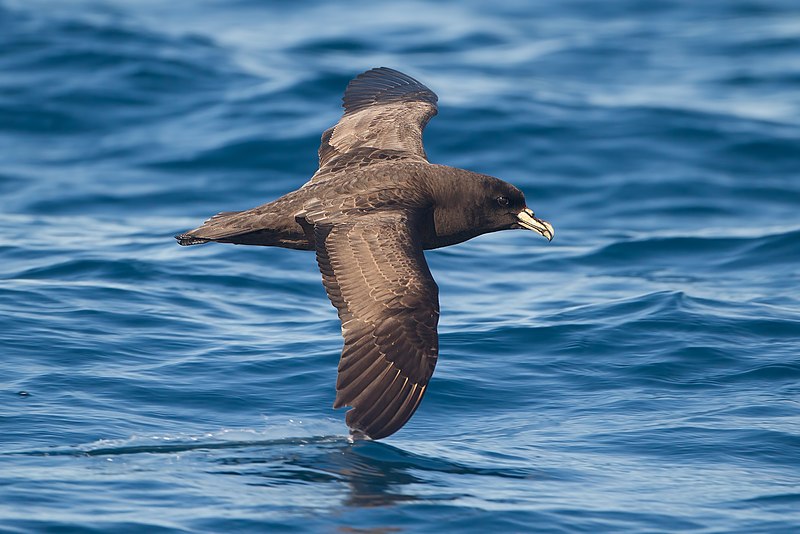
The White-chinned Petrel is a large seabird belonging to the Procellariidae family. It can be found in oceans around the Southern Hemisphere, ranging from Australia to Peru and Namibia.
These birds breed colonially on scattered islands and are sometimes known as Cape hens or Shoemakers.
They have unique white chins that distinguish them from other petrels, such as their former conspecies Spectacled Petrel.
Their wingspan averages about 115 cm across and they travel up to 4400 km during migration season.
The White-chinned Petrel feeds mainly on small fish, squid and zooplankton; it dives into the ocean for its prey using its strong webbed feet.
This species has an impressive lifespan of more than 35 years – making these majestic creatures some of our oldest avian companions.Scientific classification:
| Kingdom | Animalia |
| Phylum | Chordata |
| Class | Aves |
| Order | Procellariiformes |
| Family | Procellariidae |
| Genus | Procellaria |
| Species | P. aequinoctialis |
Also Featured In: Passage Islands Birds You Should Know, Welcome Islands Birds You Need To Know
15. Northern Giant Petrel
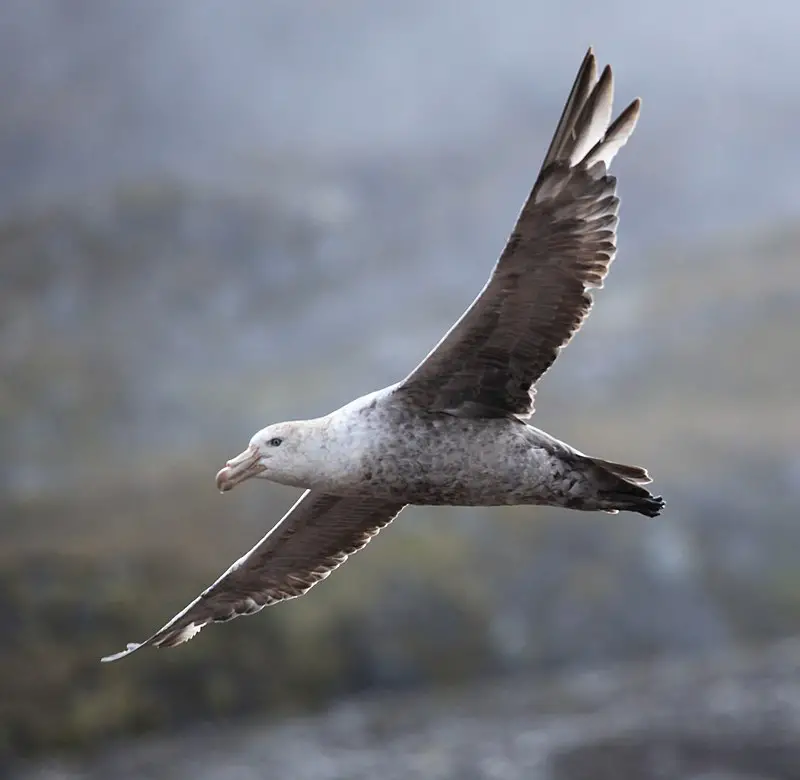
The Northern Giant Petrel is a large seabird of the southern oceans and belongs to the Macronectes family. It has broad distribution, overlapping with that of its cousin -the Southern Giant Petrel- but slightly northward.
First described in 1912 by Australian ornithologist Gregory Mathews as a subspecies of the Southern Giant Petrel, it reaches up to 75 cm long and weighs 3 kg on average.
Its plumage is dark grey above while white below, having black bill tipped with yellow or pink color along an orange line running from base to tip; its feet are also bright yellowish-orange in hue.
This species feeds mainly on fish and squid near coastal waters or scavenges carcasses farther away out at sea during winter months when food sources become scarce closer inland.Scientific classification:
| Kingdom | Animalia |
| Phylum | Chordata |
| Class | Aves |
| Order | Procellariiformes |
| Family | Procellariidae |
| Genus | Macronectes |
| Species | M. halli |
Also Featured In: Birds that Live in Gold Coasts,
16. White-Headed Petrel
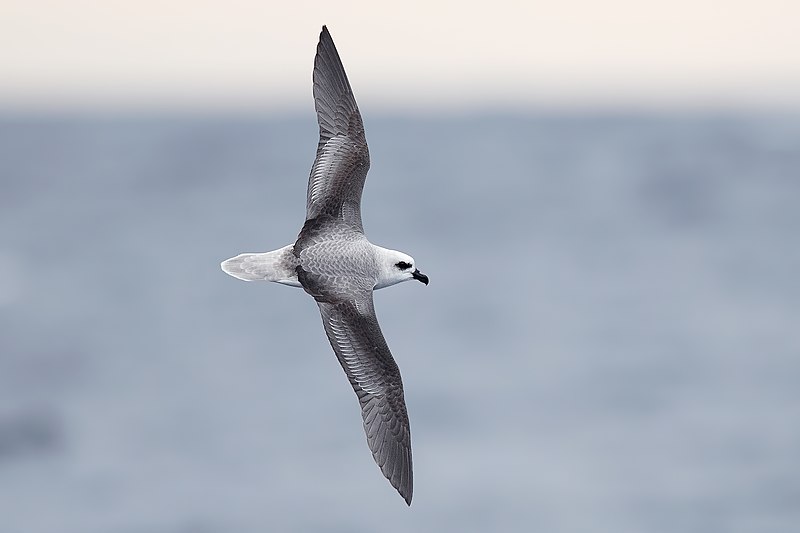
The White-headed Petrel is an adorable seabird belonging to the petrel family, Procellariidae. It has a length of about 400 mm (16 in) and can be found on subantarctic islands where it breeds either alone or colonially in burrows dug among tussocks and herbfields.
The diet mainly comprises cephalopods and crustaceans which they feed upon pelagically.
These birds have white heads with dark eyes surrounded by a circular black patch near their bill; the rest of its body is greyish blue except for its wings which are black-edged with silver-grey tips.
They tend to use dynamic soaring during migration when flying long distances over water as well as land while searching for food sources along their route.
In addition, they also rely heavily on winds blowing from east to west across oceans due to them being able to fly further faster while conserving energy at the same time.Scientific classification:
| Kingdom | Animalia |
| Phylum | Chordata |
| Class | Aves |
| Order | Procellariiformes |
| Family | Procellariidae |
| Genus | Pterodroma |
| Species | P. lessonii |
Also Featured In: Beautiful Birds Found in Central Islands,
17. Dolphin Gull
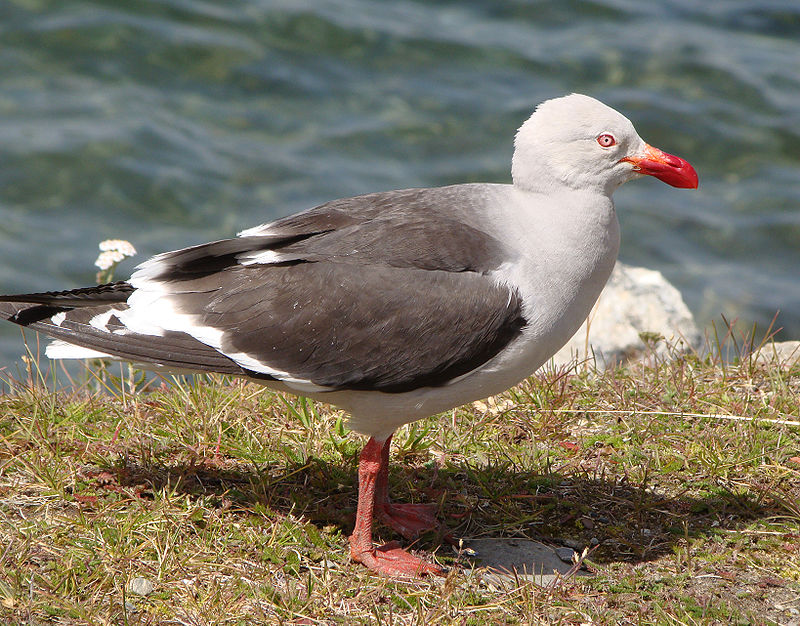
The Dolphin Gull is a medium-sized gull native to southern Chile, Argentina and the Falkland Islands. It has greyish feathers with darker wings, a yellow bill and legs of varying lengths – depending on its age.
They inhabit rocky, muddy and sandy shores near seabird colonies where they search for food such as fish, crabs or other aquatic creatures.
The adults are particularly good swimmers who can dive underwater in pursuit of their prey; whereas the young birds prefer scavenging from shoreline garbage dumps.
Dolphins Gulls form large breeding colonies during which time both males and females take part in elaborate courtship rituals to attract mates followed by nesting activities like incubating eggs together before raising chicks together too.Scientific classification:
| Kingdom | Animalia |
| Phylum | Chordata |
| Class | Aves |
| Order | Charadriiformes |
| Family | Laridae |
| Genus | Leucophaeus |
| Species | L. scoresbii |
Also Featured In: Gulls Species, Falkland Islands Birds You Need To Know
18. Rock Shag
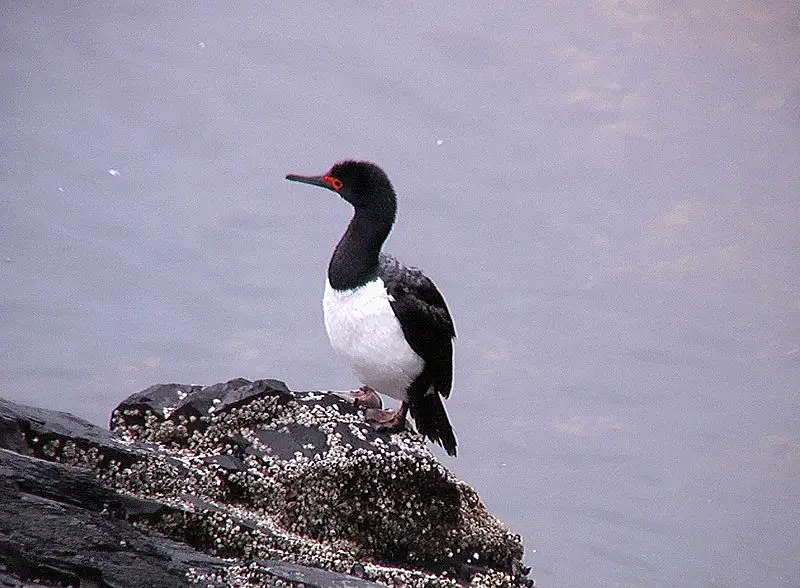
The Rock Shag is an aquatic bird found in the southernmost parts of South America, from Valdivia in Chile to Punta Tombo in Argentina. In winter, some individuals may even reach Santiago, Chile and Uruguay on both coasts.
It has a blackish-brown plumage with white patches around its wings and neck area. Its beak is hooked at the end and it also features yellow eyes and legs.
The Rock Shag feeds mainly on fish but can also prey upon squid or crustaceans depending on the availability of food sources near their breeding grounds.
They are often seen swimming close to shorelines searching for food while using their feet as paddles.
Their habitat consists mostly of rocky shores with coastal cliffs where they can build nests amongst rocks or trees such as cypresses nearby water bodies like lagoons or estuaries which provide them shelter during high tides when fishing becomes impossible due to strong currents.Scientific classification:
| Kingdom | Animalia |
| Phylum | Chordata |
| Class | Aves |
| Order | Suliformes |
| Family | Phalacrocoracidae |
| Genus | Leucocarbo |
| Species | L. magellanicus |
Also Featured In: Cormorant Species,
19. Chilean Swallow
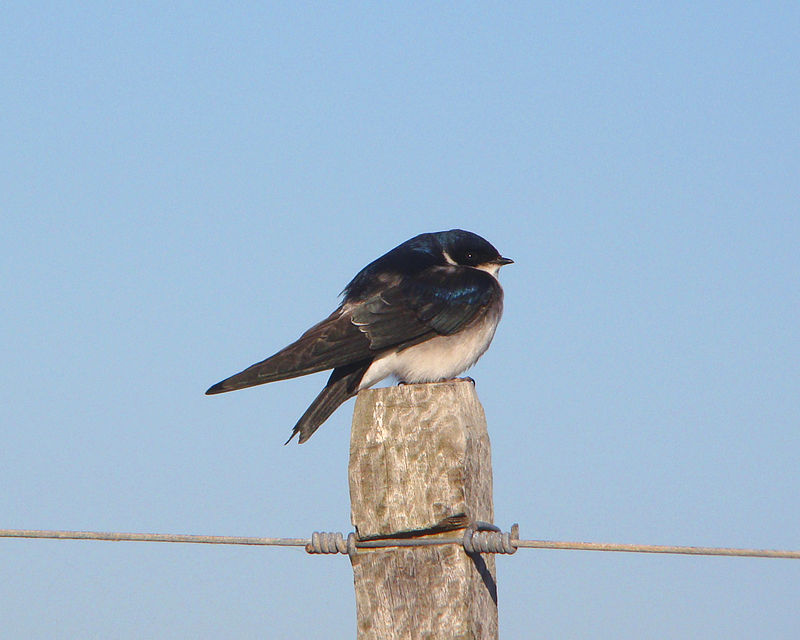
The Chilean swallow is a species of bird in the family Hirundinidae, which breeds mainly in Chile and Patagonia. It migrates northwards to Bolivia, Paraguay and Rio Grande do Sul during certain times of year.
The genus Tachycineta was created for this group by Jean Cabanis in 1850; its name originated from Ancient Greek takhukinetos meaning “moving quickly”.
This fast-flying swallow has white underparts with blue upperparts on both males and females.
Its tail is deeply forked with glossy black feathers at the tip while its bill is blackish-grey above but pale below.
During breeding season they may form large colonies near rivers or streams where they build cup shaped nests made out of mud pellets lined with grasses or hair found nearby their chosen nesting site.Scientific classification:
| Kingdom | Animalia |
| Phylum | Chordata |
| Class | Aves |
| Order | Passeriformes |
| Family | Hirundinidae |
| Genus | Tachycineta |
| Species | T. leucopyga |
Also Featured In: Swallows Species,
20. Austral Thrush
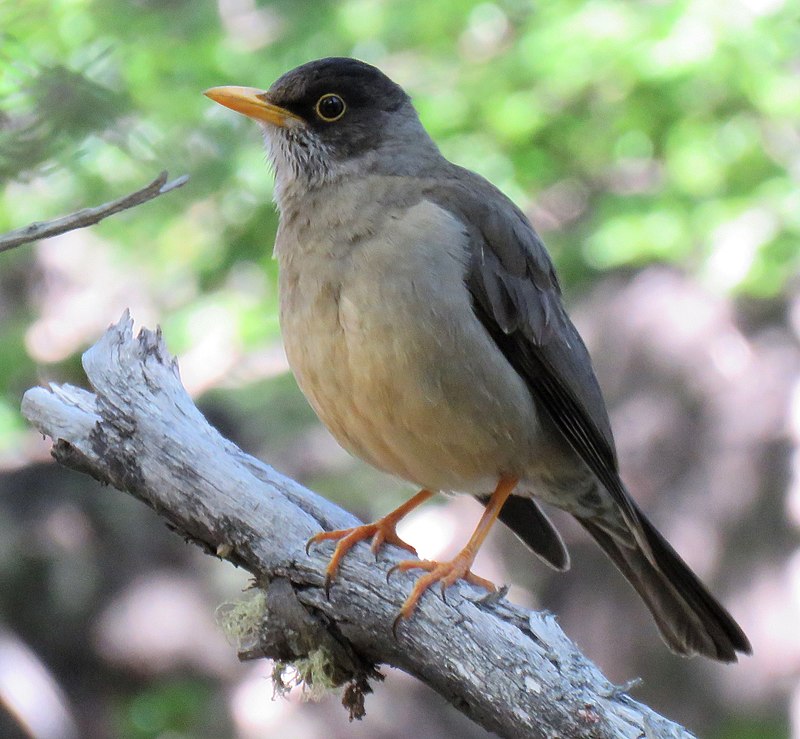
The Austral Thrush is a beautiful bird, native to Southern South America and the Falkland Islands.
It has a black body with white spots on its wings, yellow bill and feet, along with orange eyes which make it very distinctive.
The two subspecies of this bird are known as the Magellan thrush (T.f magellanicus) from southern Argentina and Chile; while the other subspecies is called the Falkland thrush (T.f falcklandii).
This species makes its habitat in thickets or open woodland areas where they feed mainly on insects by foraging through leaf litter such as worms or millipedes etc., They also consume fruits available in their environment too.
These birds form monogamous pairs during breeding season that breed once a year producing 3-4 eggs at most each time but usually only one survives due to competition among siblings when food resources become scarce.Scientific classification:
| Kingdom | Animalia |
| Phylum | Chordata |
| Class | Aves |
| Order | Passeriformes |
| Family | Turdidae |
| Genus | Turdus |
| Species | T. falcklandii |
Also Featured In: Thrush Species, Patagonia Birds You Should Know
21. Silvery Grebe
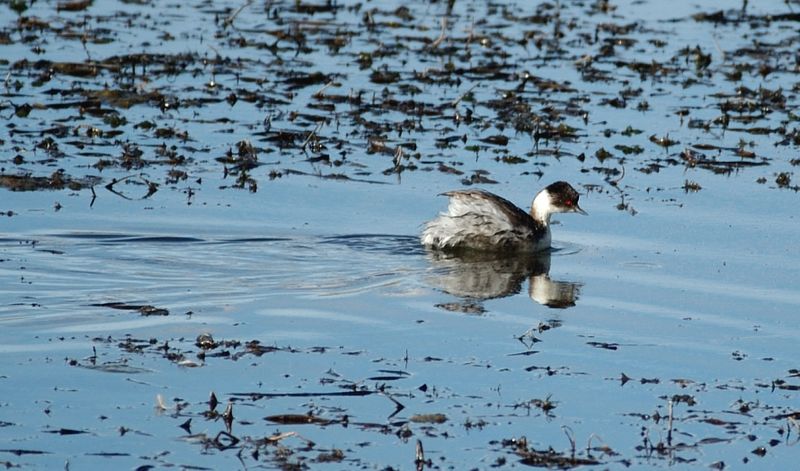
The Silvery Grebe is a freshwater bird found in the western and southern parts of South America. It can survive in altitudes of up to 4,000 metres and is even known to feed in saline lakes.
Measuring about 28 cm in length, this bird has two different subspecies with varying coloring on their heads.
The Silvery Grebe mainly feeds on small fish, crustaceans and aquatic vegetation.
Their natural habitat is freshwater lakes where they build their nests among aquatic plants. The Silvery Grebe has a unique appearance with a silvery-gray plumage and red eyes.
They are usually seen swimming on the surface of the water or diving to forage for food.
Their conservation status is currently listed as Least Concern.Scientific classification:
| Kingdom | Animalia |
| Phylum | Chordata |
| Class | Aves |
| Order | Podicipediformes |
| Family | Podicipedidae |
| Genus | Podiceps |
| Species | P. occipitalis |
Also Featured In: Silver Birds You Should Know, Birds That Live around East Falkland
22. Patagonian Sierra Finch
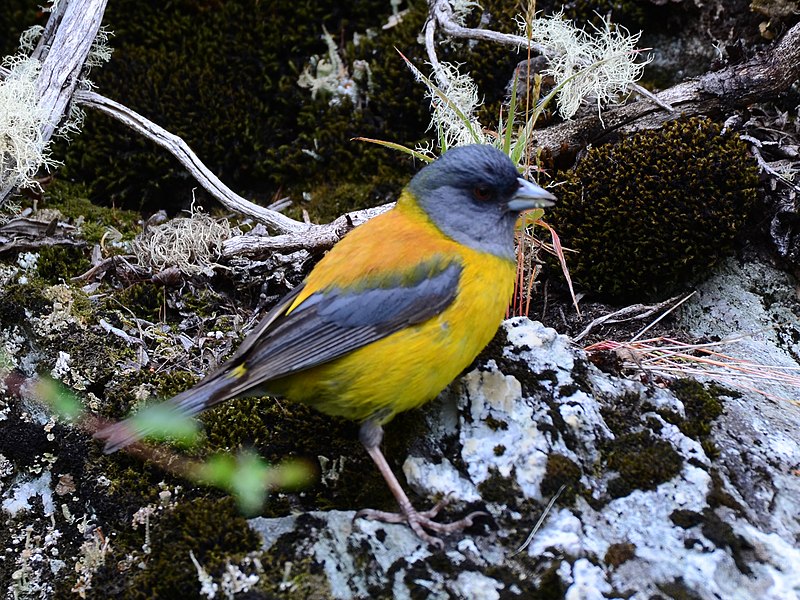
The Patagonian sierra finch is a species of bird that can be found in Argentina and Chile. It typically resides in temperate forests, subtropical or tropical dry shrubland, and temperate grassland.
Its diet consists of seeds, flower parts, nectar, fruit, and insects.
However, it has also been known to forage on human refuse. This bird belongs to the Thraupidae family and is known for its unique and colorful appearance.
With its diverse diet and adaptable nature, the Patagonian sierra finch has managed to thrive in diverse environments.Scientific classification:
| Kingdom | Animalia |
| Phylum | Chordata |
| Class | Aves |
| Order | Passeriformes |
| Family | Thraupidae |
| Genus | Phrygilus |
| Species | P. patagonicus |
Also Featured In: Common Birds in Chiloé Island,
23. Black-Faced Ibis
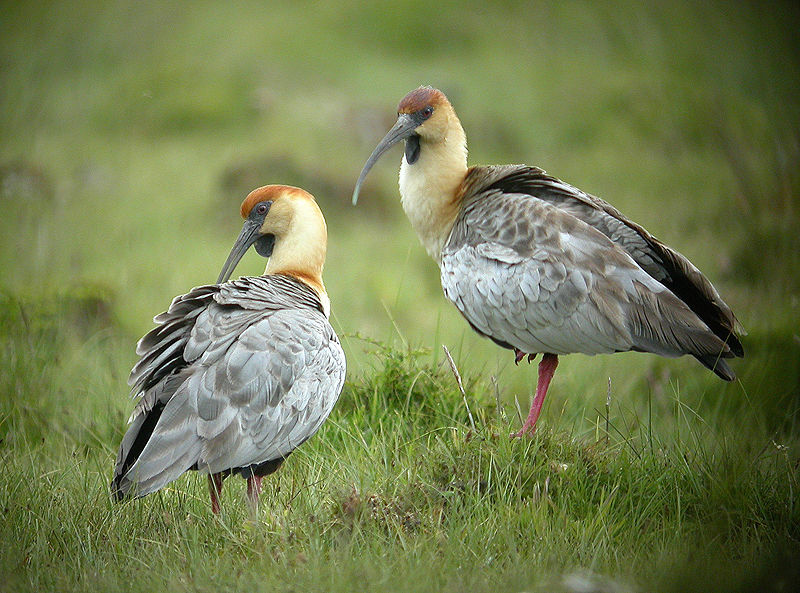
The black-faced ibis is a bird species belonging to the Threskiornithidae family. It is commonly found in grasslands and fields in southern and western parts of South America.
Although it was previously considered a subspecies of buff-necked ibis, recent studies have confirmed their separate identity. The Andean ibis is also considered a subspecies of the black-faced ibis.
These birds are known for their distinct black facial feathers, and they have a long and curved bill used for foraging. They feed on a variety of small animals including insects, lizards, and small rodents.
Black-faced ibis are highly social and typically roost in groups. They are not considered endangered, although habitat loss poses a potential threat to their populations.Scientific classification:
| Kingdom | Animalia |
| Phylum | Chordata |
| Class | Aves |
| Order | Pelecaniformes |
| Family | Threskiornithidae |
| Genus | Theristicus |
| Species | T. melanopis |
24. Thorn-Tailed Rayadito
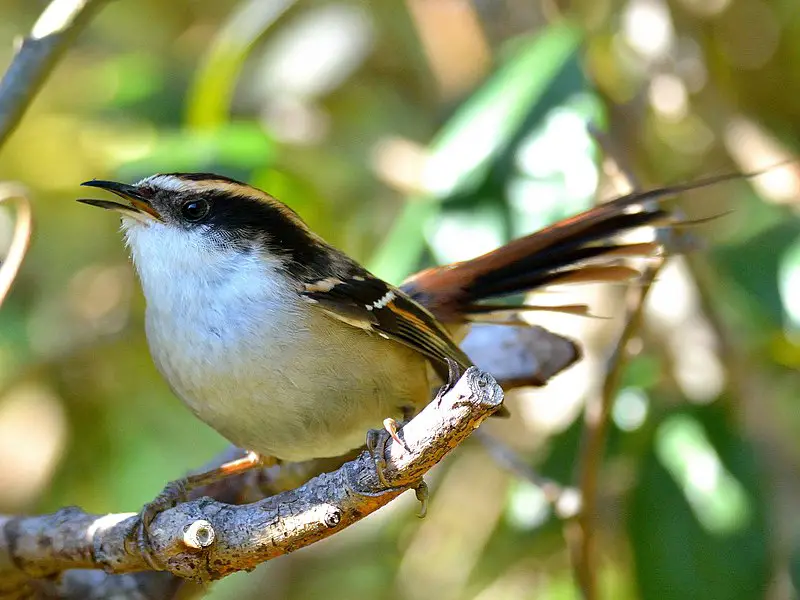
The thorn-tailed rayadito is a well-known bird found in temperate forests and subtropical dry shrubland. This bird belongs to the family Furnariidae and is primarily found in southern Chile, south of 30°S.
While some sources suggest it may have once been present in the Falkland Islands, this has not been confirmed.
Despite its limited range, the thorn-tailed rayadito is the most commonly recognized bird in the temperate forests of the Zona Austral and Zona Sur in Chile.
With its distinctive appearance, including a pointed tail and brown and white plumage, it is easily recognizable to birdwatchers and other observers.
While it is not considered endangered, the thorn-tailed rayadito is an important part of the local ecosystem and plays a crucial role in helping to disperse seeds and control insect populations.Scientific classification:
| Kingdom | Animalia |
| Phylum | Chordata |
| Class | Aves |
| Order | Passeriformes |
| Family | Furnariidae |
| Genus | Aphrastura |
| Species | A. spinicauda |
25. Austral Negrito
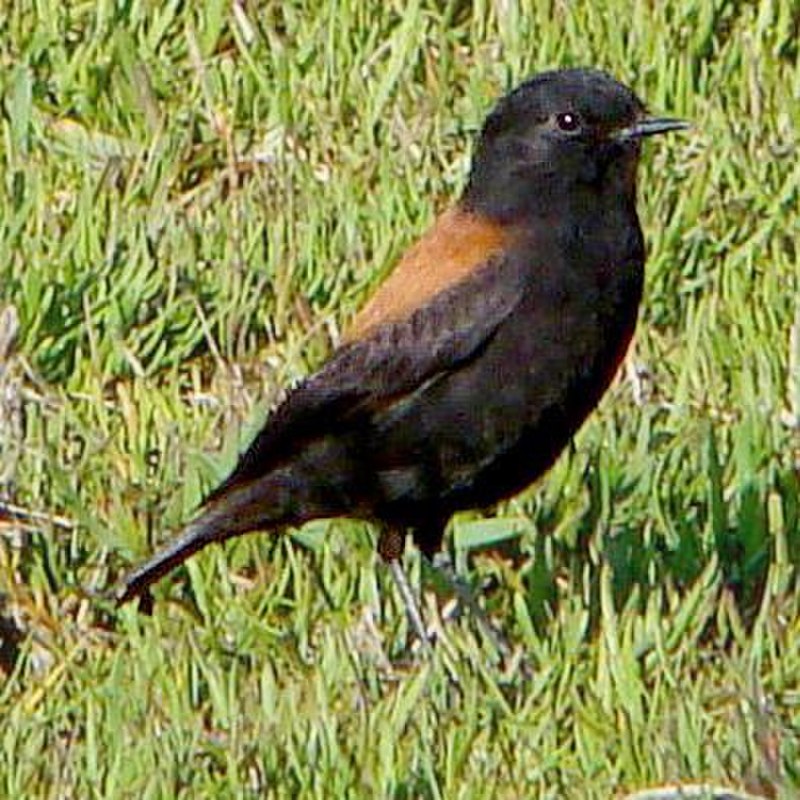
The Austral Negrito, also known as the Patagonian Negrito, is a species of bird that belongs to the Tyrannidae family.
It can be found breeding in Argentina and Chile, while migrating north to countries such as Bolivia, Brazil, Paraguay, and Uruguay.
Although it is a vagrant to the Falkland Islands and the South Georgia and South Sandwich Islands, it has also been seen in the South Shetland Islands.
The bird’s natural habitats include forests, shrublands, and grasslands. In terms of physical features, the Austral Negrito has a dark brown coloration with a white throat, a small bill, and a broad tail.
Its diet mainly consists of insects and small vertebrates. Like other migratory birds, the Austral Negrito’s movements are influenced by environmental changes, making it an important indicator of ecosystem health.Scientific classification:
| Kingdom | Animalia |
| Phylum | Chordata |
| Class | Aves |
| Order | Passeriformes |
| Family | Tyrannidae |
| Genus | Lessonia |
| Species | L. rufa |
26. Buff-Winged Cinclodes
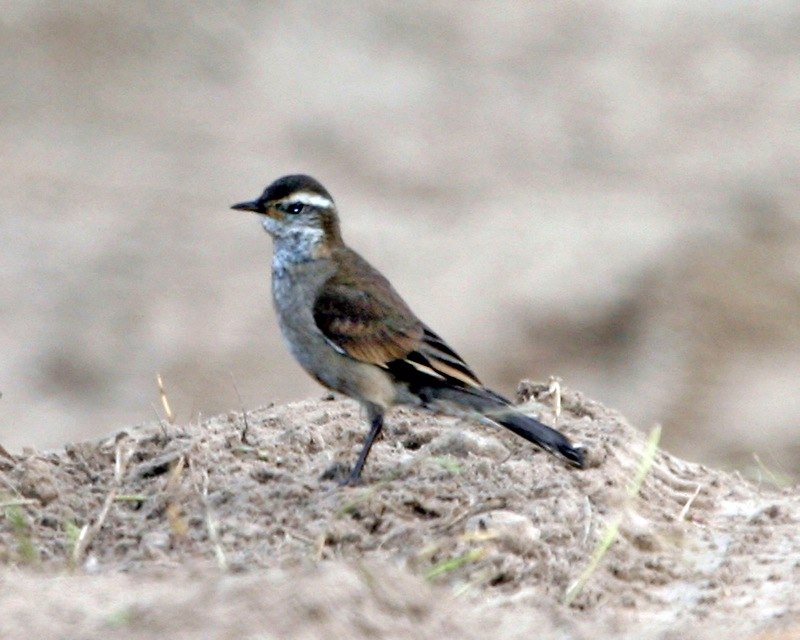
The Buff-winged cinclodes is a bird species of the Furnariidae family. It is found in eastern Chile and Argentina, and during winters it can be found in the Pampas.
It is known for its distinctive buff wings. This bird prefers to stay in subtropical or tropical high-altitude shrubland, temperate grassland, and subtropical or tropical high-altitude grassland habitats.
This species was formerly considered a subspecies of the bar-winged cinclodes.
The Buff-winged cinclodes is a small and striking bird that is known for its beautiful plumage. It is a natural part of the ecosystem and contributes to the balance of the environment.
Like many bird species, it plays an important role in pollination and seed dispersal. Its presence is essential for maintaining a healthy ecosystem.Scientific classification:
| Kingdom | Animalia |
| Phylum | Chordata |
| Class | Aves |
| Order | Passeriformes |
| Family | Furnariidae |
| Genus | Cinclodes |
| Species | C. fuscus |
27. Green-Backed Firecrown
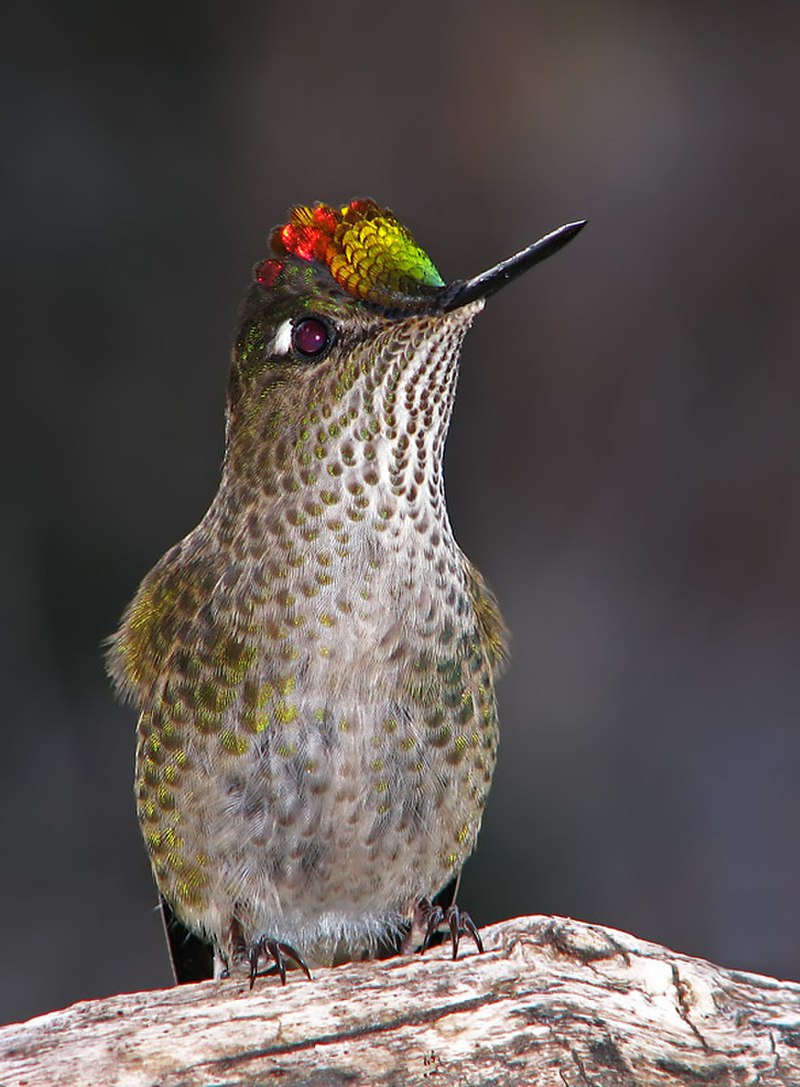
The green-backed firecrown is a unique hummingbird found in Argentina, mainland Chile, and the Juan Fernández Islands. It is the only species in its genus and shares it with only one other species, the Juan Fernandez firecrown.
This bird is commonly known as a “coquette” and belongs to the tribe Lesbiini of the subfamily Lesbiinae.
It has a distinctive green color on its back, giving it its name, and a crown of feathers on its head that often appears fiery in the sunlight.
Despite being small, the green-backed firecrown is known for being quite territorial, especially around food sources.
It is a skilled flier, able to hover in mid-air and rapidly dart from one place to another. It is also a nectar feeder and plays an important role in pollination.Scientific classification:
| Kingdom | Animalia |
| Phylum | Chordata |
| Class | Aves |
| Clade | Strisores |
| Order | Apodiformes |
| Family | Trochilidae |
| Genus | Sephanoides |
| Species | S. sephaniodes |
28. Flying Steamer Duck
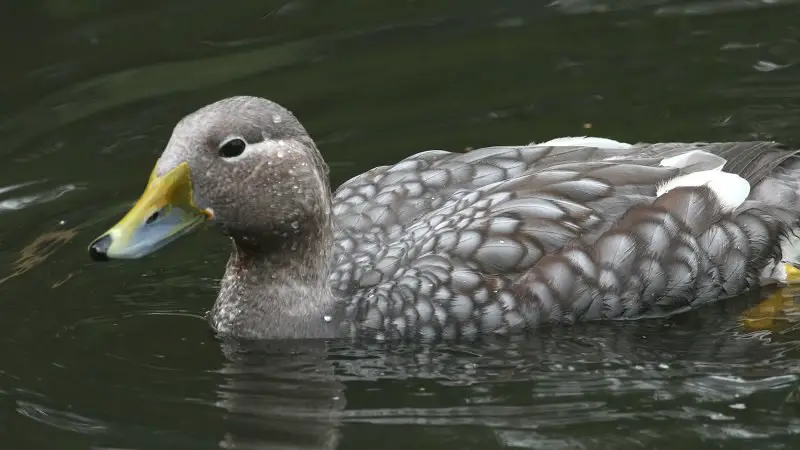
The flying steamer duck, a member of the Anatidae family, is a South American duck also known as the flying steamer-duck.
It is one of four steamer ducks in the Tachyeres genus, along with the Falkland, Fuegian, and Chubut steamer ducks.
These ducks are named for their behavior of propelling themselves through the water like a steamship with their wings.
The flying steamer duck has a distinctive white stripe above its eye and is capable of flight, unlike its flightless relatives.
Their diet consists mainly of crustaceans, mollusks, and small fish. These ducks are found in the coastal regions of southern Argentina, Chile, and the Falkland Islands.
Due to habitat loss and hunting in some areas, the species is considered Near Threatened by the IUCN Red List.Scientific classification:
| Kingdom | Animalia |
| Phylum | Chordata |
| Class | Aves |
| Order | Anseriformes |
| Family | Anatidae |
| Genus | Tachyeres |
| Species | T. patachonicus |
29. Grey-Hooded Sierra Finch
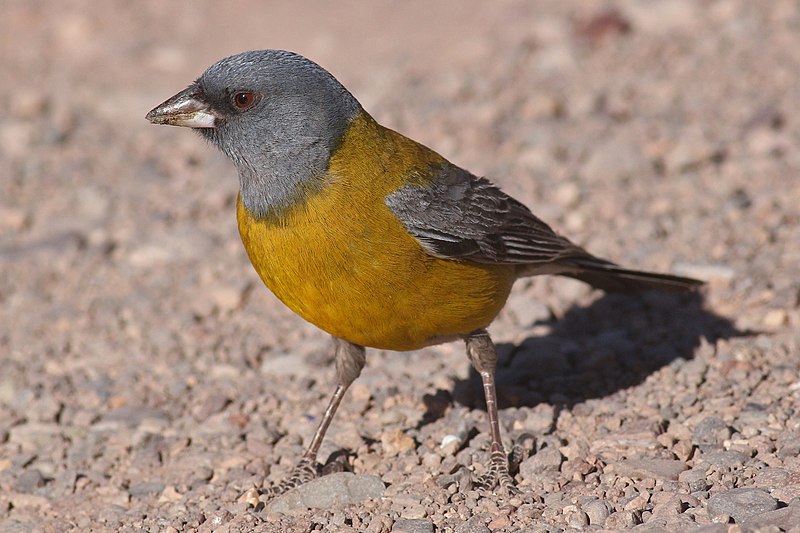
The Grey-hooded sierra finch is a species of bird belonging to the Thraupidae family. This bird is commonly found in the high-altitude shrublands of Argentina and Chile.
The natural habitats of this species are subtropical or tropical dry shrublands. The finch has a grey-colored hood on its head which distinguishes it from other finches. It is known for its beautiful song and is a popular species among bird watchers.
The Grey-hooded sierra finch is a small bird, and the males have more vibrant and colorful plumage than females.
This species is an important part of the ecosystem as it helps pollinate plants and is a food source for many predators.
Despite being relatively common in some regions, the Grey-hooded sierra finch is still considered a species of least concern according to the International Union for Conservation of Nature (IUCN).Scientific classification:
| Kingdom | Animalia |
| Phylum | Chordata |
| Class | Aves |
| Order | Passeriformes |
| Family | Thraupidae |
| Genus | Phrygilus |
| Species | P. gayi |
30. Ashy-Headed Goose
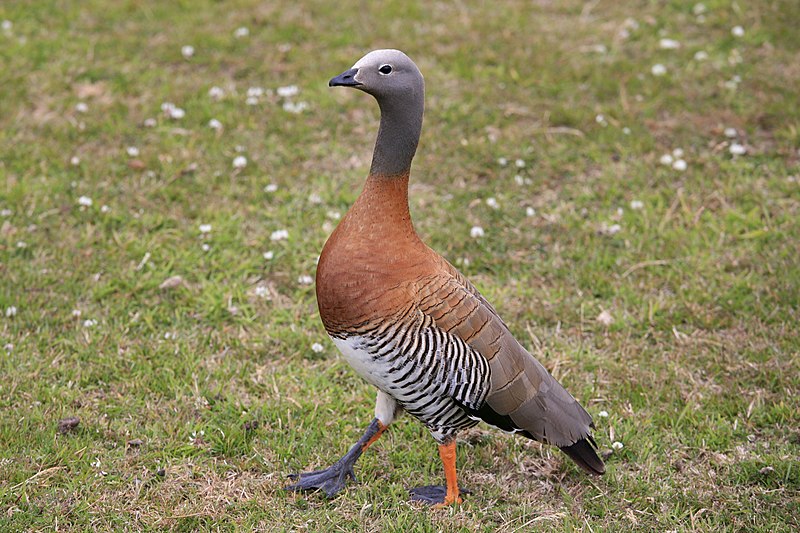
The Ashy-headed goose is a waterfowl species found in Argentina and Chile. It is the only member of its genus.
The birds measure 50-60 cm in length, with males weighing 1.62-2.27 kg and females weighing 1.47-1.49 kg.
Both sexes have the same plumage with ashy-grey heads and necks. These geese inhabit freshwater lakes, ponds, and rivers, feeding on aquatic vegetation and small invertebrates.
During the breeding season, they form monogamous pairs, with females laying 6-10 eggs in a nest constructed from grasses and feathers.
As a migratory species, they move to more southern areas during the winter. Threats to the Ashy-headed goose include hunting and habitat loss from agriculture and urbanization.
Conservation efforts are underway to protect their populations.Scientific classification:
| Kingdom | Animalia |
| Phylum | Chordata |
| Class | Aves |
| Order | Anseriformes |
| Family | Anatidae |
| Genus | Chloephaga |
| Species | C. poliocephala |
31. Austral Canastero
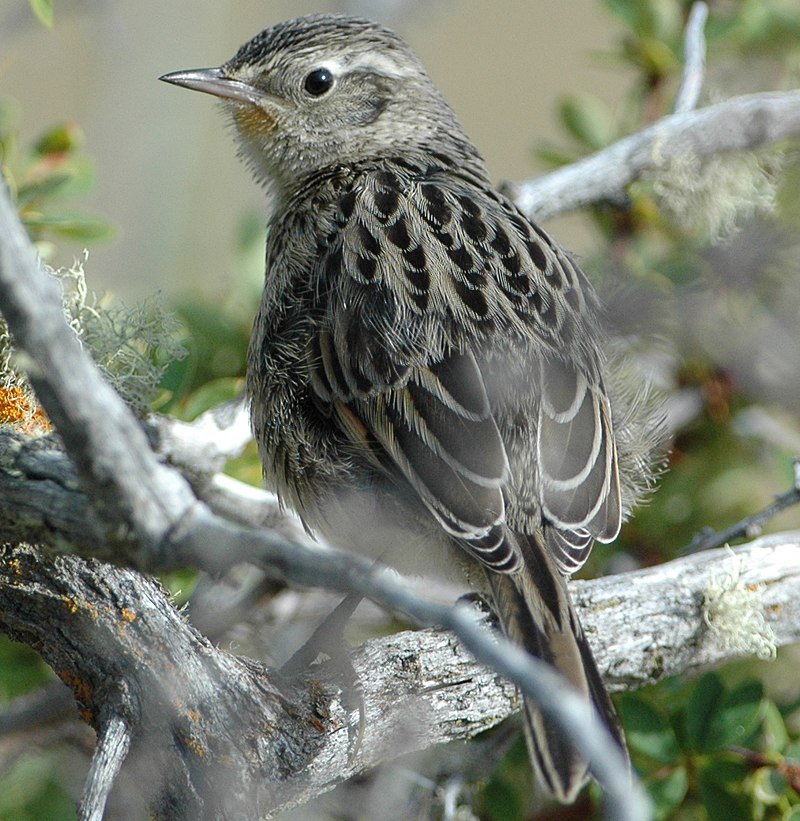
The Austral canastero bird belongs to the family Furnariidae and is found in southern Argentina and Chile. This species is partly migratory and extends its range northwards during the austral winter.
Its natural habitats consist of temperate shrublands and grasslands in non-arid regions of Patagonia. Foraging on the ground for insects, the Austral canastero is a unique and fascinating bird species.Scientific classification:
| Kingdom | Animalia |
| Phylum | Chordata |
| Class | Aves |
| Order | Passeriformes |
| Family | Furnariidae |
| Genus | Asthenes |
| Species | A. anthoides |
32. White-Bellied Seedsnipe
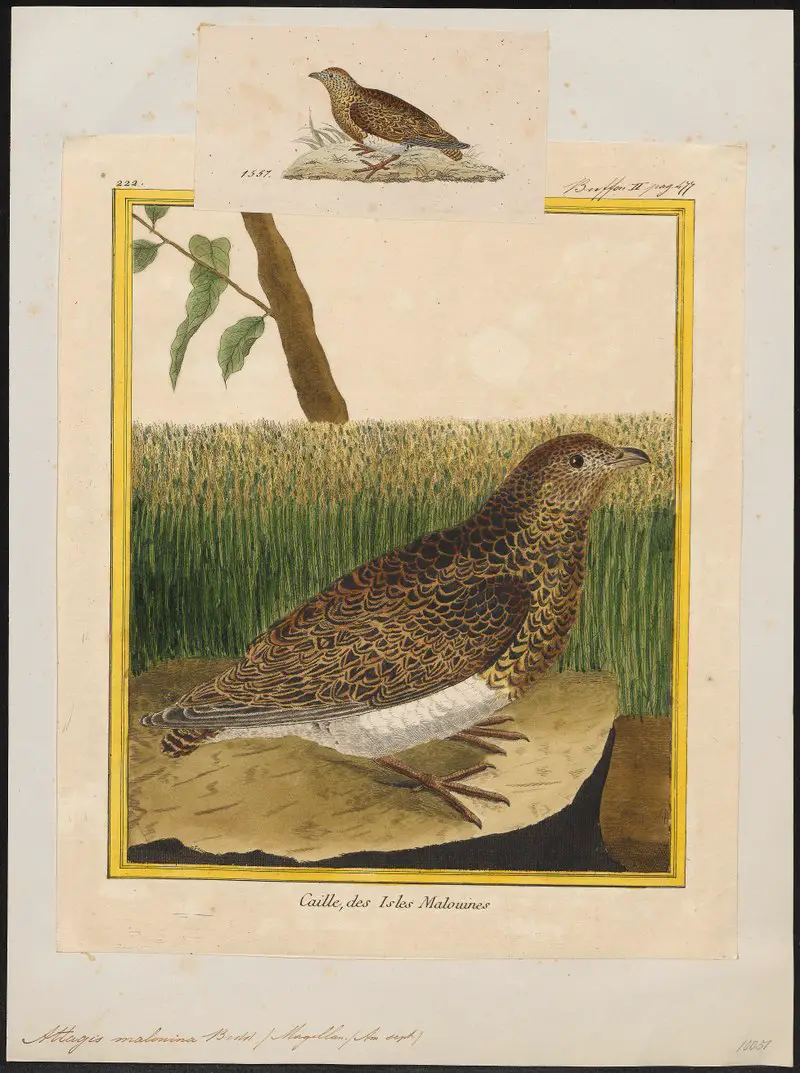
The White-bellied seedsnipe is a bird species belonging to the suborder Scolopaci of Charadriiformes order.
It is mainly found in Argentina and Chile. This bird was first described by Georges-Louis Leclerc, Comte de Buffon in 1772 based on a specimen collected on the Falkland Islands.
The White-bellied seedsnipe is a small-sized bird species and primarily feeds on seeds, making it distinct from other shorebirds. It is named after its white belly and exhibits a brownish-grey color on its upper parts.
This bird inhabits steep, rocky regions and avoids wetland areas. Due to its elusive nature and remote habitat, not much is known about the bird’s conservation status.
However, the population is believed to be stable due to the bird’s restricted range and lack of threats.Scientific classification:
| Kingdom | Animalia |
| Phylum | Chordata |
| Class | Aves |
| Order | Charadriiformes |
| Family | Thinocoridae |
| Genus | Attagis |
| Species | A. malouinus |
33. Yellow-Bridled Finch
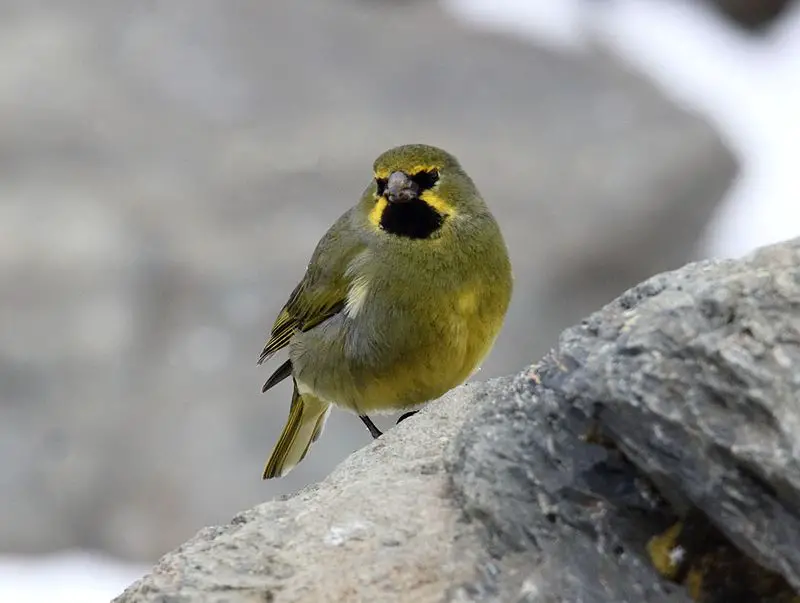
The Yellow-bridled finch is a bird species belonging to the family Thraupidae, endemic to Argentina and Chile.
It can be found in high-altitude grasslands ranging from tropical regions in the north to sub-Antarctic Tierra del Fuego and Cape Horn in the south.
The male Yellow-bridled finch has grey and yellow plumage with black markings around the face and neck, while females and juveniles have a mottled appearance.
This bird’s natural habitat is essential to its survival, and it contributes to the biodiversity of these environments.
Observing this beautiful bird in their natural habitats is a great addition to any birdwatching experience, and their range of yellow and gray plumage make them easy to spot amongst the grasslands.
The Yellow-bridled finch is a delightful sight to see and a true delight to bird enthusiasts.Scientific classification:
| Kingdom | Animalia |
| Phylum | Chordata |
| Class | Aves |
| Order | Passeriformes |
| Family | Thraupidae |
| Genus | Melanodera |
| Species | M. xanthogramma |
34. Rufous-Chested Plover
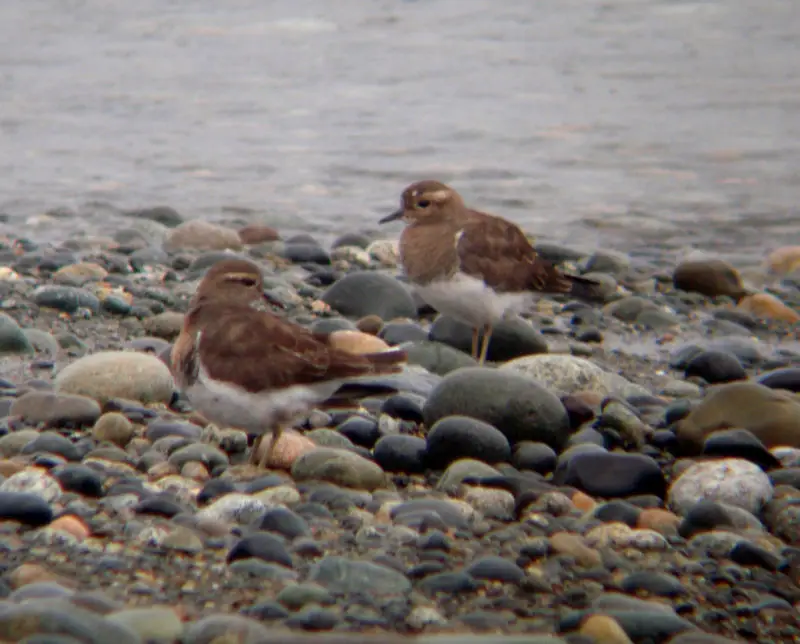
The Rufous-chested plover, also known as the Rufous-chested dotterel, is a bird species found in Argentina, Brazil, Chile, Uruguay, and the Falkland Islands.
Though some authors classify it in the Zonibyx genus, this treatment isn’t widely adopted. It belongs to the Charadriidae family’s Charadriinae subfamily. It is a small bird with a distinct rufous or reddish-brown chest.
Its feathers are brown and white with a black beak and legs. These birds prefer living in damp habitats like riverbanks, marshes, and wetlands. They feed on insects, worms, and small fish.
The conservation status of this species is considered “Least Concern” because its population is relatively stable.Scientific classification:
| Kingdom | Animalia |
| Phylum | Chordata |
| Class | Aves |
| Order | Charadriiformes |
| Family | Charadriidae |
| Genus | Charadrius |
| Species | C. modestus |
Also Featured In: Birds That Live In Tristan da Cunha,
35. Kelp Goose
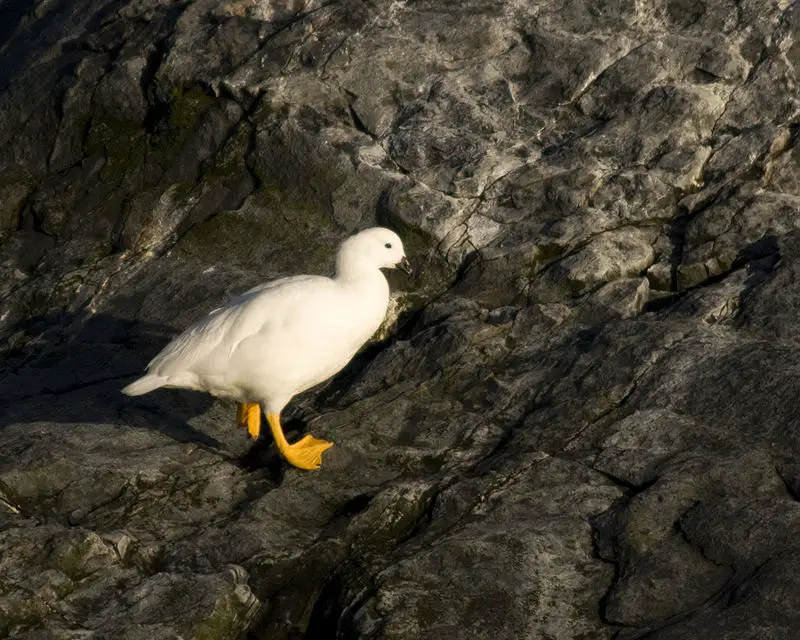
The kelp goose is a species of waterfowl found in Argentina, Chile, and the Falkland Islands. It belongs to the Tadornini tribe of subfamily Anserinae. This bird has two subspecies, C. h. hybrida and C. h. malvinarum.
The kelp goose is a medium-sized bird, measuring 55 to 65 cm in length. Male kelp geese of its nominate subspecies weigh 2.54 to 2.58 kg, while females weigh 2.00 to 2.17 kg.
These birds are known for their beautiful feathers, and their striking appearance makes them a popular species among bird enthusiasts.
Due to their aquatic nature, kelp geese are often spotted near the water, feeding on aquatic plants and insects.
They are an important part of the ecosystem and play a significant role in maintaining an ecological balance.Scientific classification:
| Kingdom | Animalia |
| Phylum | Chordata |
| Class | Aves |
| Order | Anseriformes |
| Family | Anatidae |
| Genus | Chloephaga |
| Species | C. hybrida |
Also Featured In: Native Birds Of West Falkland, Common Birds of Weddell Island
36. Crested Duck
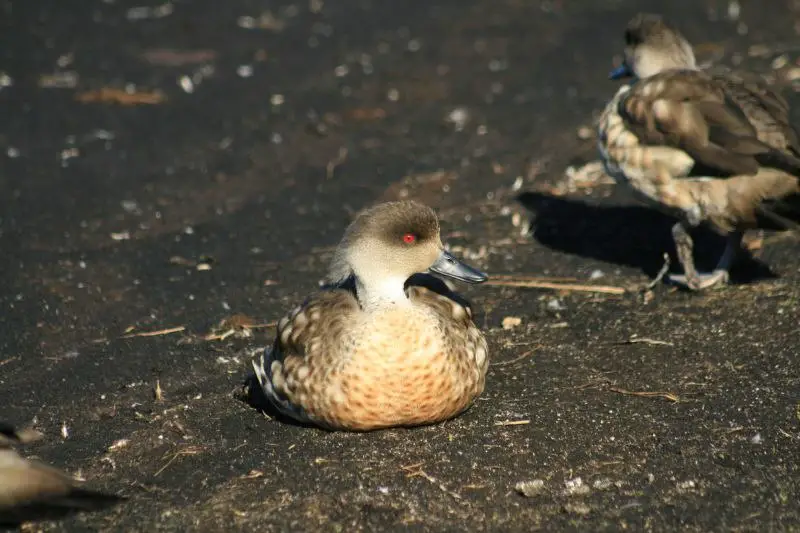
The Crested Duck, also known as the South American Crested Duck, is a unique waterbird species found in South America.
This monotypic duck belonging to the Lophonetta genus is sometimes mistakenly included in the Anas species.
However, its divergent origins from early dabbling duck evolution have marked its distinction. This species has two subspecies – Lophonetta specularioides alticola or Andean Crested Duck, and Lophonetta specularioides specularioides.
The Crested Duck is a delightful bird with a small crest on its head, which is often raised during courtship displays.
The species is commonly found in freshwater lakes, marshes, rivers, and streams. They are known to feed on a diverse range of aquatic vegetation and small aquatic creatures.
The Crested Duck’s unique features, behavior, and habitat make it a fascinating bird to observe in its natural settings.Scientific classification:
| Kingdom | Animalia |
| Phylum | Chordata |
| Class | Aves |
| Order | Anseriformes |
| Family | Anatidae |
| Subfamily | Anatinae |
| Genus | Lophonetta Riley, 1914 |
| Species | L. specularioides |
37. Tufted Tit-Tyrant
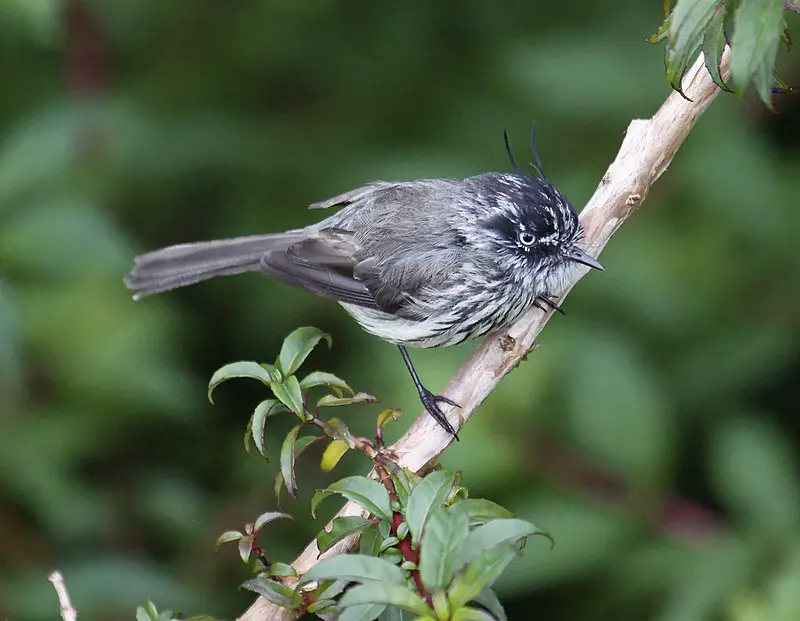
The tufted tit-tyrant is a bird species belonging to the Tyrannidae family, found in the western regions of South America. It inhabits upper montane forests and shrublands, although it can be seen in a diverse range of ecosystems.
With a habitat spanning from southern Colombia to Tierra del Fuego, it is known to be a generalist in its preferences.
The bird’s scientific name is Anairetes parulus, and it has distinct tufted feathers on its head. Despite its name, it is not closely related to the tit family of birds found in Europe and Asia.
Being a tyrant flycatcher, the tufted tit-tyrant feeds on insects and other small prey, swooping upon them from a perch.
Its vocalizations include a high-pitched trill or a series of short notes. This bird is an important indicator species of habitat destruction or degradation due to its specialized habitat preferences.Scientific classification:
| Kingdom | Animalia |
| Phylum | Chordata |
| Class | Aves |
| Order | Passeriformes |
| Family | Tyrannidae |
| Genus | Anairetes |
| Species | A. parulus |
38. Dark-Bellied Cinclodes
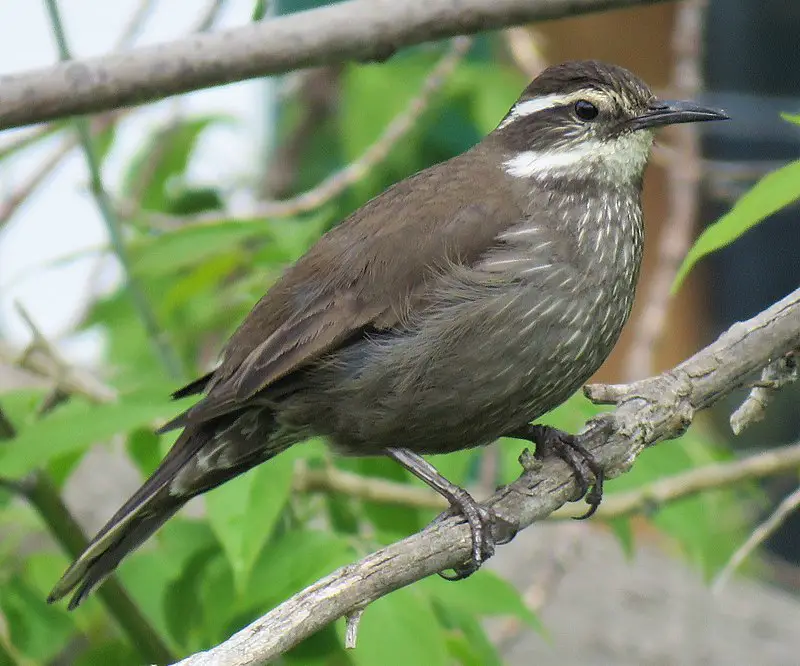
The Dark-bellied cinclodes is a species of bird in the Furnariidae family found in Argentina and Chile. Its natural habitats include rivers and rocky shores.
This bird is commonly spotted in regions south of Santiago down to Tierra del Fuego and western Argentina. It can be found around marshlands, lakes, and streams at sea level.
The distinguishing feature of this species is a dark belly, which gives it its name. Although not much is known about their behavior, they are known to play a crucial role in their ecosystem, contributing to seed dispersal and insect control.
Overall, the Dark-bellied cinclodes is a unique and important member of the avian community in South America.Scientific classification:
| Kingdom | Animalia |
| Phylum | Chordata |
| Class | Aves |
| Order | Passeriformes |
| Family | Furnariidae |
| Genus | Cinclodes |
| Species | C. patagonicus |
39. White-Crested Elaenia
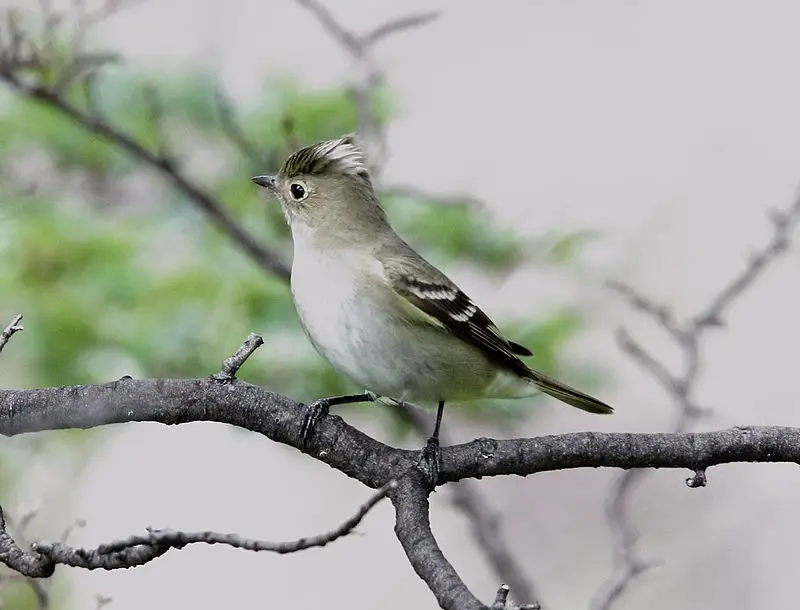
The White-crested elaenia is a bird belonging to the family Tyrannidae. It is found breeding across southern and western parts of South America, and migrates north in the winter.
This species has several subspecies and is typically found in temperate forests, subtropical or tropical moist montane forests, as well as subtropical or tropical high-altitude shrubland.
It has a distinct white crest on its head, which makes it easy to identify. The White-crested elaenia feeds primarily on insects and is known for its swift and acrobatic hunting techniques.
Due to habitat loss and fragmentation, along with other environmental threats, the White-crested elaenia is facing population declines in some regions.
Conservation efforts are needed to protect this species and its important role in its ecosystems.Scientific classification:
| Kingdom | Animalia |
| Phylum | Chordata |
| Class | Aves |
| Order | Passeriformes |
| Family | Tyrannidae |
| Genus | Elaenia |
| Species | E. albiceps |
Also Featured In: South Shetland Islands Birds You Need To Know,
40. Ochre-Naped Ground Tyrant
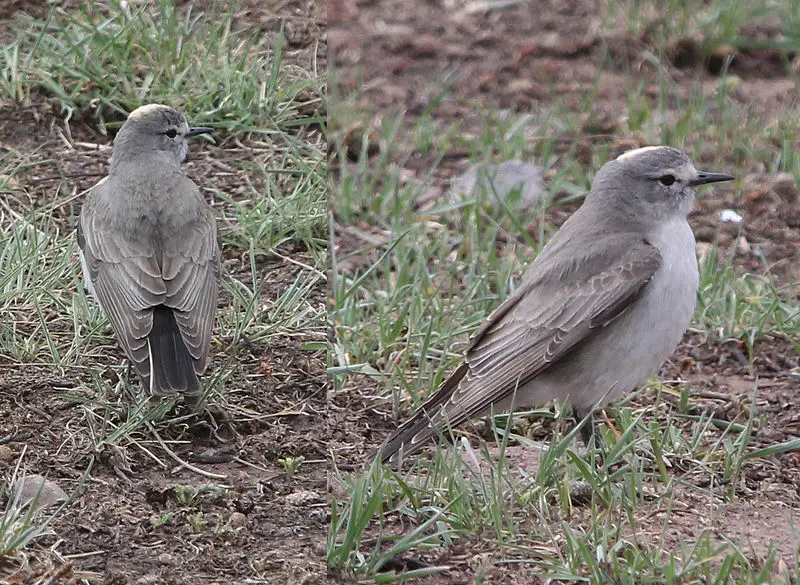
The Ochre-naped ground tyrant is a bird belonging to the family Tyrannidae, found in Argentina, Bolivia, Chile, and Peru. These birds inhabit temperate grassland and subtropical/tropical high-altitude grassland.
The species is known for its distinct ochre-colored nape, which sets it apart from other ground tyrants.
They breed in the Andes region of southern Peru to the west. Often spotted near the ground, these insectivorous birds feed on small prey like insects and spiders.
They are known to be territorial in nature and have a distinct, high-pitched, trilling call. These birds are also known for their acrobatic flight patterns, often seen making quick turns in pursuit of their prey.
The Ochre-naped ground tyrant is a significant bird species in the Andean ecosystem and is often studied to further understand the biodiversity of the region.Scientific classification:
| Kingdom | Animalia |
| Phylum | Chordata |
| Class | Aves |
| Order | Passeriformes |
| Family | Tyrannidae |
| Genus | Muscisaxicola |
| Species | M. flavinucha |
41. White-Winged Coot
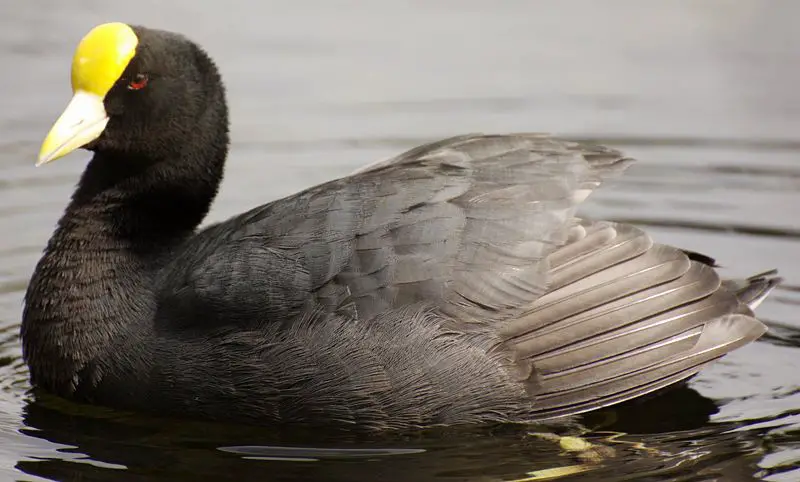
The White-winged coot is a bird species belonging to the Rallidae family. They are found in several countries including Argentina, Bolivia, Chile, and the Falkland Islands.
It is a monotypic species that has a length of 35 to 43 cm and weighs 400 to 600 g. The sexes appear similar in appearance. This species is known for its distinctive wings that are mostly white.
They inhabit freshwater lakes, ponds, and wetlands. White-winged coots feed on aquatic plants and insects.
They are relatively shy and territorial birds, sometimes engaging in aggressive behavior towards other members of their species.
Despite being widespread, information about the population size and trends of the White-winged coot is still limited.Scientific classification:
| Kingdom | Animalia |
| Phylum | Chordata |
| Class | Aves |
| Order | Gruiformes |
| Family | Rallidae |
| Genus | Fulica |
| Species | F. leucoptera |
42. Blackish Cinclodes
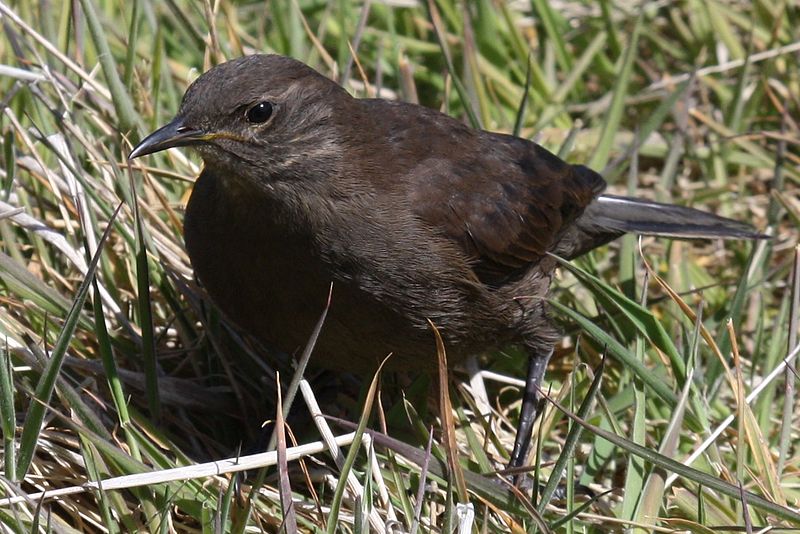
The Blackish cinclodes is a bird belonging to the family Furnariidae, native to the southern tip of South America and the Falkland Islands. It is also known as the tussac-bird or tussock-bird.
This passerine bird species is a small-sized bird measuring around 18-23 cm long. Both male and female birds share similar physical characteristics and they have almost identical plumage.
The bird can be easily tamed and often approaches humans closely, making it a common sighting in the region.
The Blackish cinclodes is an interesting bird to observe and study for bird enthusiasts and scientists alike due to its unique behaviors and habitat preferences in the Falkland Islands.Scientific classification:
| Kingdom | Animalia |
| Phylum | Chordata |
| Class | Aves |
| Order | Passeriformes |
| Family | Furnariidae |
| Genus | Cinclodes |
| Species | C. antarcticus |
Also Featured In: Jason Islands Birds You Didn’t Know,
43. Dark-Faced Ground Tyrant
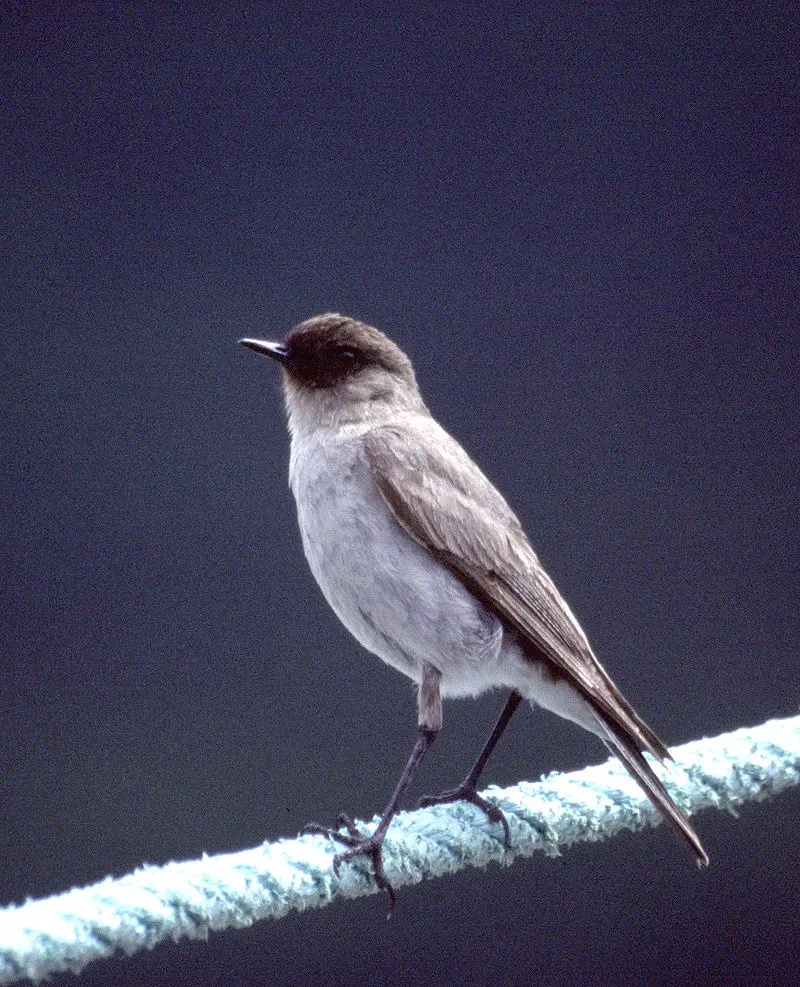
The Dark-faced ground tyrant is a small bird found in the southern Andes region and the Falkland Islands. It belongs to the tyrant flycatcher family and feeds on small invertebrates like flies and moths.
This ground-dwelling bird is 16 cm long, and the male is slightly larger than the female. It has long legs and a dark face, which gives it its name.
The dark-faced ground tyrant is known for its ability to forage on the ground, where it can be seen running and pouncing on its prey.
Its diet consists mainly of insects, and it uses its sharp beak to catch them. This bird is often found in mountainous regions and can survive in harsh conditions due to its strong adaptability.
The dark-faced ground tyrant is a fascinating species, and its unique features make it a popular subject for bird watchers and photographers alike.Scientific classification:
| Kingdom | Animalia |
| Phylum | Chordata |
| Class | Aves |
| Order | Passeriformes |
| Family | Tyrannidae |
| Genus | Muscisaxicola |
| Species | M. maclovianus |
44. Magellanic Tapaculo
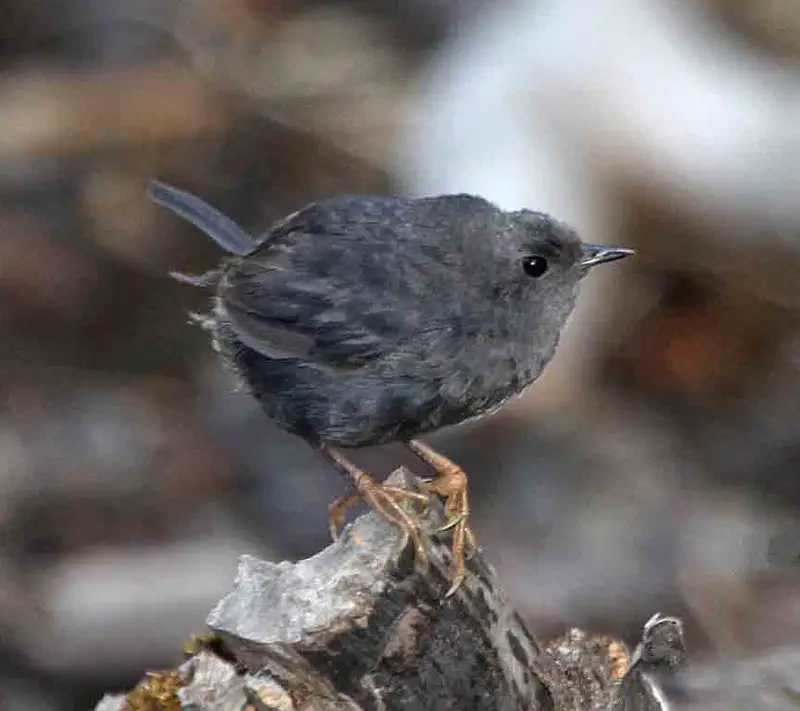
The Magellanic tapaculo is a tiny passerine bird found in the southern regions of South America. This bird is part of the Scytalopus genus of tapaculos.
Formerly known as the Andean tapaculo, it was a part of a group of subspecies that were distributed along the Andes.
However, these subspecies were later recognized as their own distinct species, leaving the Magellanic tapaculo without any subspecies.
Despite its small size, this bird is known for its distinctive vocalizations and is often heard more than seen.
Its plumage is predominantly brown with subtle variations, making it well-camouflaged in its natural habitat.
This bird is an important part of the southern South American ecosystem and plays a crucial role in pollination and seed dispersal.Scientific classification:
| Kingdom | Animalia |
| Phylum | Chordata |
| Class | Aves |
| Order | Passeriformes |
| Family | Rhinocryptidae |
| Genus | Scytalopus |
| Species | S. magellanicus |
45. Black-Chinned Siskin
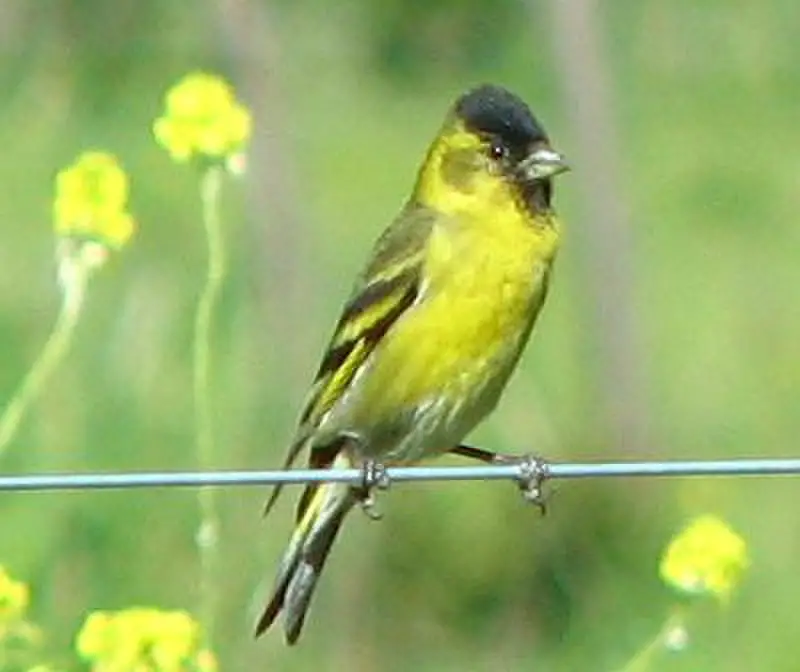
The Black-chinned siskin is a type of finch found in Argentina, Chile, and the Falkland Islands. Its natural habitats are temperate forests and degraded former forests.
This bird grows up to 13 centimetres in length. The male has a black crown and upper throat, with the rest of the head and upper body covered in yellow-green feathers.
This bird is one of the most common species of siskin found in the wild, and its diet consists mainly of seeds.
The Black-chinned siskin is known for its sweet melodious voice and is often kept as a pet bird.
Conservation efforts have been put in place to protect this bird’s habitat and ensure its survival in the wild.Scientific classification:
| Kingdom | Animalia |
| Phylum | Chordata |
| Class | Aves |
| Order | Passeriformes |
| Family | Fringillidae |
| Subfamily | Carduelinae |
| Genus | Spinus |
| Species | S. barbatus |
46. White-Throated Caracara
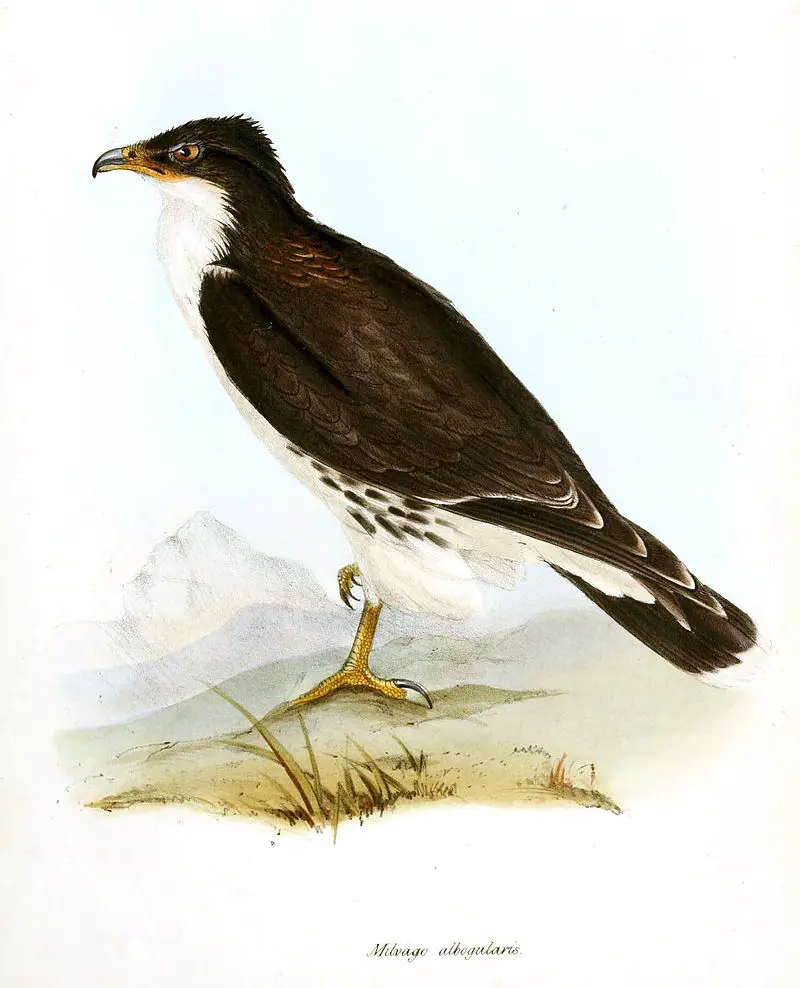
The White-throated caracara, also known as Darwin’s caracara, belongs to the Falconidae family and is a bird of prey. This species can be found in Argentina and Chile.
It is a member of the Falconiformes order, which has various taxonomic systems with different numbers of species, genera, and subfamilies.
The caracaras are known for their strong and sharp beaks, which they use to feed on carcasses of dead animals, fruits, insects, and small vertebrates.
They are also known for their distinctive behavior of scavenging and stealing food from other birds.
The White-throated caracara is considered an important species in some South American cultures due to its association with symbolic and spiritual values.Scientific classification:
| Kingdom | Animalia |
| Phylum | Chordata |
| Class | Aves |
| Order | Falconiformes |
| Family | Falconidae |
| Genus | Phalcoboenus |
| Species | P. albogularis |
47. Correndera Pipit
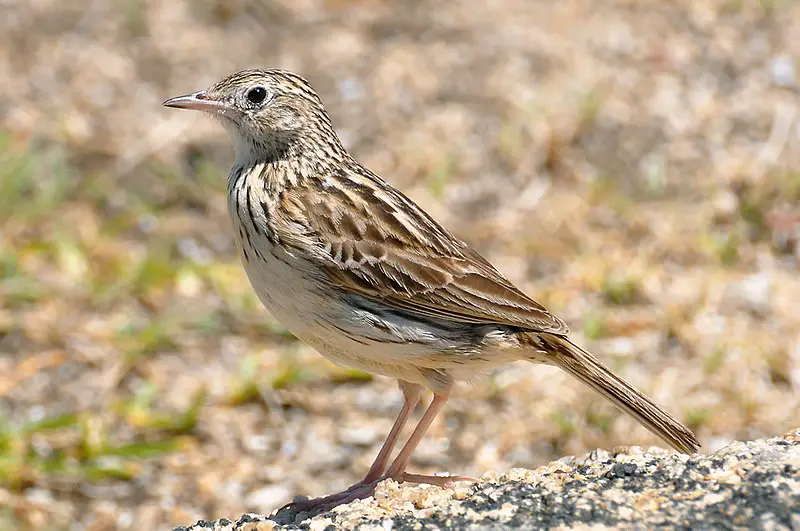
The Correndera pipit is a bird belonging to the Motacillidae family. It is commonly found in various regions, including Argentina, Bolivia, Chile, Uruguay, and Peru.
This species thrives in natural habitats such as temperate grasslands, subtropical or tropical high-altitude grasslands, and pastures.
The Correndera pipit is a small bird typically spotted in open fields, where it feeds on insects and spiders.
Its wings are brownish and grayish, which helps it blend in with its surroundings. The bird is known for its beautiful, melodic songs that are often used for communication with other members of its species.
The Correndera pipit is an important part of many grassland ecosystems, where it plays a crucial role in maintaining the balance of the ecosystem through its unique feeding habits.Scientific classification:
| Kingdom | Animalia |
| Phylum | Chordata |
| Class | Aves |
| Order | Passeriformes |
| Family | Motacillidae |
| Genus | Anthus |
| Species | A. correndera |
48. Patagonian Tyrant
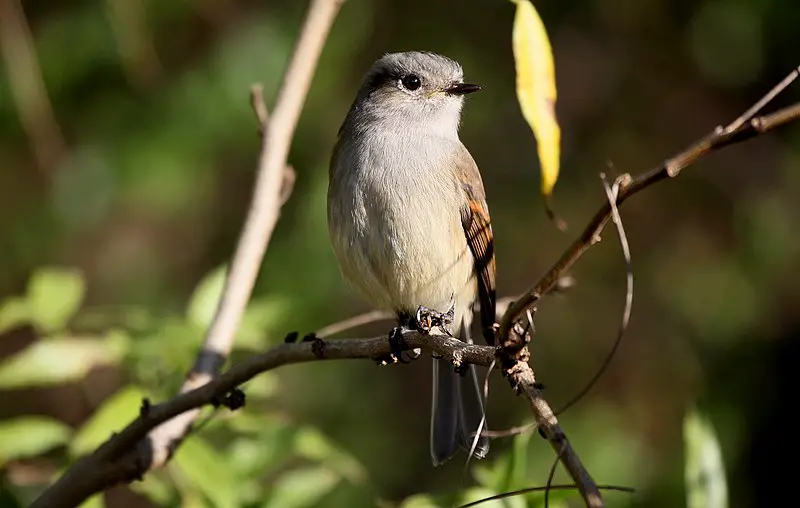
The Patagonian tyrant bird is a unique species of bird belonging to the family Tyrannidae. It is the only bird in the genus Colorhamphus and is commonly found in Argentina and Chile.
These birds inhabit temperate forests and primarily feed on insects. However, they have also been observed eating the seeds of mayten and the fruit of leñadura. Despite being insectivorous, they have a diverse diet.
Due to their distinctive features and natural habitat, these birds serve as an essential part of the ecosystem.
Their contribution to the environment cannot be ignored. These amazing birds exist in harmony with nature, living their lives in the temperate forests of Argentina and Chile.Scientific classification:
| Kingdom | Animalia |
| Phylum | Chordata |
| Class | Aves |
| Order | Passeriformes |
| Family | Tyrannidae |
| Genus | Colorhamphus Sundevall, 1872 |
| Species | C. parvirostris |
49. Austral Blackbird
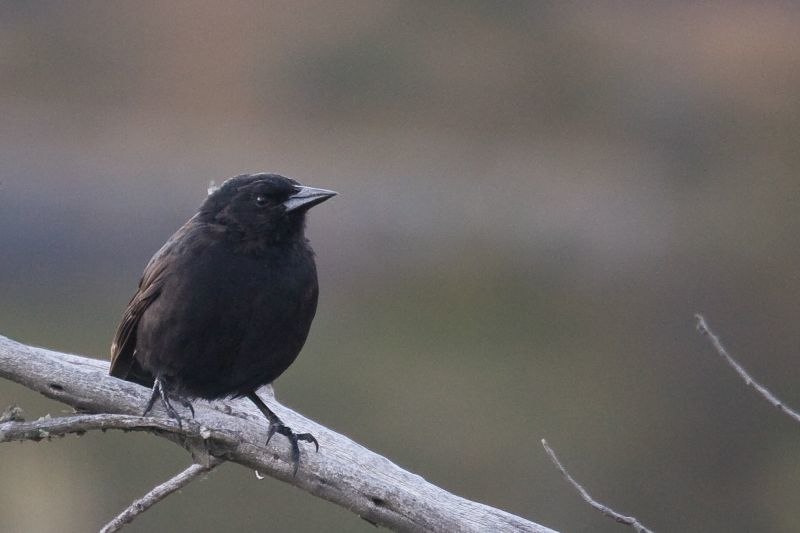
The Austral blackbird, also known as Curaeus curaeus, belongs to the Icteridae family of birds.
This species can be found in Argentina and Chile, preferring temperate forests, subtropical, or tropical high-altitude shrublands.
Unfortunately, this bird’s natural habitat has been heavily degraded in former forests. With its black feathers and bright yellow eye, the Austral blackbird is a visually stunning bird. It is known to be omnivorous, often feeding on insects, fruit, and seeds.
These birds are known for their dynamic calls, which can be heard from far away. Despite their unique appearance and vocalizations, the population of Austral blackbirds faces potential threats from habitat loss and human disturbance.
Conservation efforts need to focus on preserving their natural habitats to ensure their continued survival.Scientific classification:
| Kingdom | Animalia |
| Phylum | Chordata |
| Class | Aves |
| Order | Passeriformes |
| Family | Icteridae |
| Genus | Curaeus (PL Sclater, 1862) |
| Species | C. curaeus |
50. Red Shoveler
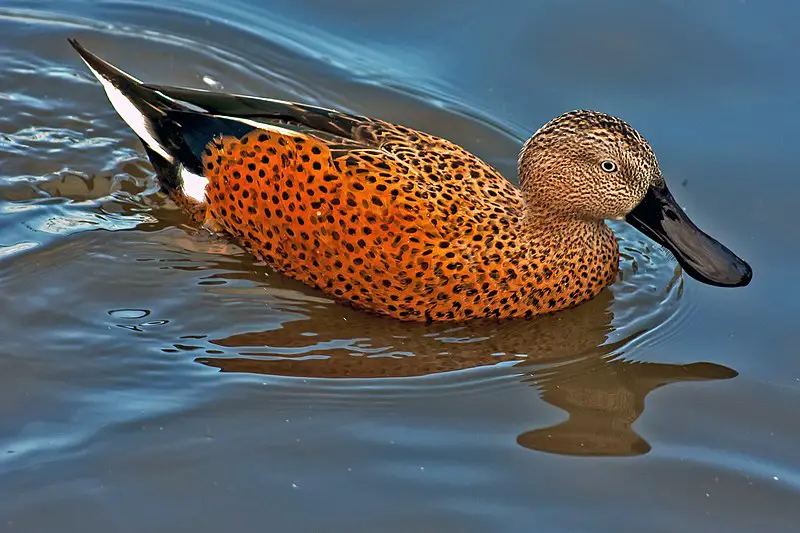
The red shoveler is a type of dabbling duck that is found in southern South America. Measuring about 45-56 centimeters long and weighing around 523-608 grams, this bird is known for its distinctive spatula-shaped bill and green speculum.
Male shovelers can range in color from bright red to paler shades of pink, while females usually have larger, darker bills. One interesting feature of the red shoveler is its light blue upper wing coverts.
These birds prefer to feed on algae, plants, and invertebrates found in shallow water, which they filter through their bills.
Despite being a common sight in their native habitat, the red shoveler is not very well known outside of South America.
Conservation efforts are currently underway to protect this unique and colorful species.Scientific classification:
| Kingdom | Animalia |
| Phylum | Chordata |
| Class | Aves |
| Order | Anseriformes |
| Family | Anatidae |
| Genus | Spatula |
| Species | S. platalea |
51. Bronze-Winged Duck
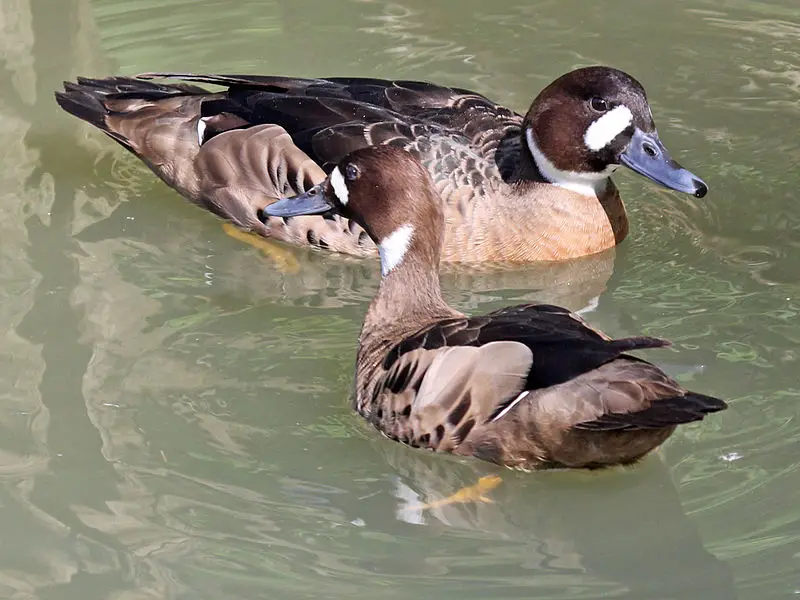
The Bronze-winged duck is a unique and distinctive bird species found in South America. This dabbling duck is the only member of its genus, Speculanas, and is often classified with other dabbling ducks in the Anas genus.
However, it is closely related to either the crested duck or the Brazilian duck, which are also monotypic genera.
The Bronze-winged duck gets its name from the striking bronze-colored feathers on its wings. It is also known as the spectacled duck due to the white patches around its eyes that resemble spectacles.
This duck prefers freshwater habitats such as rivers, streams, and lagoons. The Bronze-winged duck has a unique whistling call and feeds on aquatic plants, insects, and small aquatic animals.
Although not considered endangered, this species faces some threats from habitat loss and hunting in some areas.Scientific classification:
| Kingdom | Animalia |
| Phylum | Chordata |
| Class | Aves |
| Order | Anseriformes |
| Family | Anatidae |
| Genus | Speculanas von Boetticher, 1929 |
| Species | S. specularis |